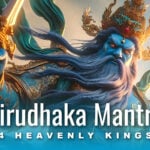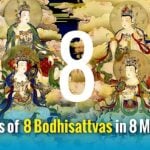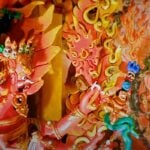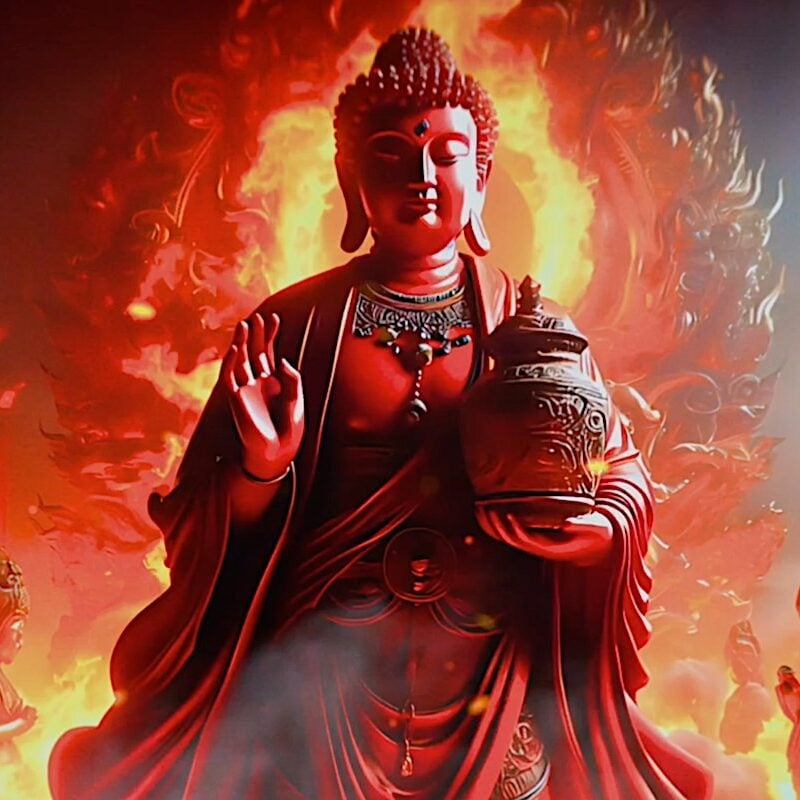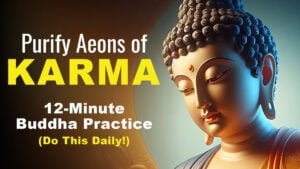Buddha Day – Chokhor Duchen Celebrating the First Teaching: How to celebrate Buddha’s First Turning of the Wheel of Dharma — this year on July 9 or 10, 2024

Of the four Holy Days dedicated to Shakyamuni Buddha each year, Chokhor Duchen, the “First Teaching” celebration — the first turning of the Wheel of Dharma — is the most important. This year in Tibetan Buddhist Tradition, it is celebrated on July 9 or 10, 2024, depending on your lunar calendar. FPMT calculates it as July 10, while some other centres have it as July 9 — due to lunar skip days. There are also time-zone differences. The important thing is to celebrate the first teaching!
In Buddhism, we take refuge in Buddha, Dharma and Sangha, but the Dharma — the teachings (Dharma) — is considered the most important. The true refuge is in Buddha’s teachings and the conduct and practices he taught — and no teaching was more important than the first discourse.
From FPMT website: “Chokhor Duchen, one of the four annual holy days of Guru Shakyamuni Buddha, takes place this year on July 9 or July 10 depending on the various Tibetan calendars. Both days are fine. On these holy days of Guru Shakyamuni Buddha, the power of any meritorious action is multiplied by 100 million, as taught in the vinaya text Treasure of Quotations and Logic.”
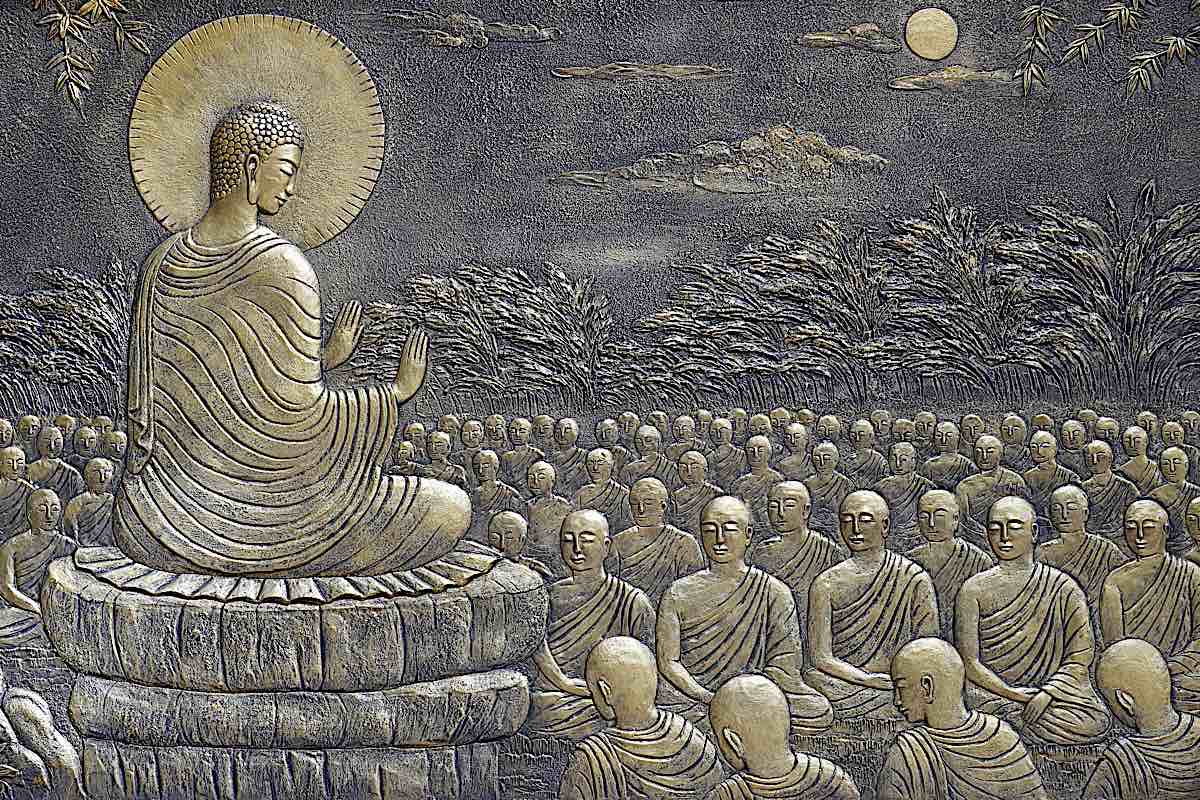
In this feature, we explain the Holy Days and offer many meritorious practice recommendations for the most Holy of Days Chokhor Duchen. In this feature we offer dozens of practices, long and short, with links to other suggested practices from venerable teachers.
Chokhor Duchen commemorates the day when Buddha gave his first teaching, the turning of the Wheel of Dharma, at Sarnath. It is also known as Sangha Day, because it celebrates the founding of the Buddhist monastic order.
According to Lama Zopa: “Chokhor Duchen, one of the four annual holy days of Guru Shakyamuni Buddha, takes place on the 4th day of the 6th Tibetan lunar month. On these holy days, the power of any meritorious action is multiplied by 100 million, as taught in the vinaya text Treasure of Quotations and Logic.”
Reciting Sutras is Highly Meritorious on Buddha Days:
Reciting Sutras — Highly Meritorious on Buddha Days!
Among the most auspicious and meritorious of practices on Buddha Days is recitation of Sutras. This can be in Sanskrit, Pali, Tibetan, English, or any language.
Two of the most meritorious are the Sutra Remembering the Three Jewels and the Heart Sutra. We have recitations as videos in English and Sanskrit embedded throughout this feature, starting with the Sutra Remembering the Three Jewels, which is recommended by Lama Zopa for Buddha Days:
- Don’t miss the verified timeline of Shakyamuni Buddha’s life in the section below “Buddha’s Life” with dates or in the video below:
Extra merit for practices on Chokhor Duchen
On Chokhor Duchen, we celebrate by doing extra practices and dedication for the benefit of all beings. This can include reciting sutras, making offerings to the Sangha, practicing bodhichitta — the mind of awakening — and giving charity. [At the end of this feature, we excerpted some valuable practices for recitation on the Holy Day August 1, with links to extensive other practices.]

When we dedicate our actions on Chokhor Duchen to others, we create powerful merit that will help them in this life and in future lives. If you’ve been thinking about taking up a new practice or making a change in your life, Chokhor Duchen is an excellent day to start.
No matter what you do on Chokhor Duchen, the most important thing is to remember the spirit of the day: giving and benefiting others. When we focus on others, our own happiness naturally increases. So take some time on August 1st to think about how you can benefit others, and make it a special day for everyone.
As one of the four major days celebrating the shining life of Shakyamuni Buddha, the Conqueror, according to sutra, the merit of all practices is multiplied at least 100,000 times.
The one overwhelming theme of Chokhor Duchen is joy, life affirmation, and compassion for all beings.
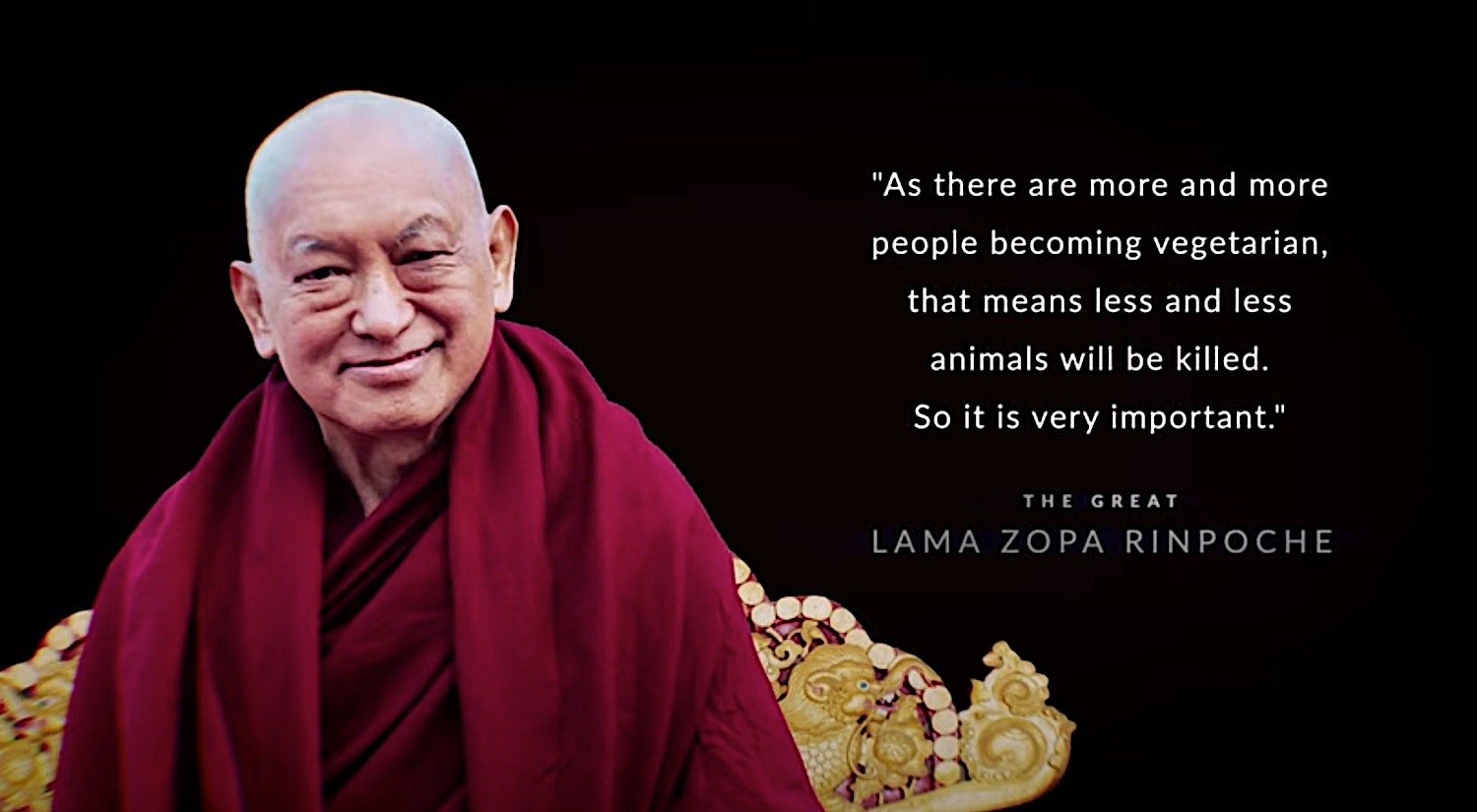
This is why we might eat a vegetarian meal — to honor our fellow sentient beings — or engage in acts of charity or kindness. On this day, most Buddhists — and non-Buddhists to honour the day of compassion — will typically engage in the five lay precepts, to paraphrase them concisely:
- Refrain from taking life (hence vegan for the day!)
- Refrain from taking what is not given.
- Refrain from misuse of all our senses.
- Refrain from wrong speech (gossip, lies, and so on)
- Refrain from intoxicants that cloud the mind.
[See section “Precepts” below for more detail.]
The First Teaching, Meet the Buddha in Deer Park: Video
In a lovely video, our editor visualizes “stumbling on the Buddha” in Deer Park and eavesdropping on the first turning of the Wheel of Dharma. Don’t miss this lovely visualization:
Practices to honor Chokhor Duchen
Some practices recommended by teachers for this very special day, which falls on August 1st this year include :
1. Chanting Sutras [Why reciting sutras out loud is important feature>>]
Chanting the Heart Sutra, here in English (Sanskrit version above):https://www.youtube.com/watch?v=9Yvs8B9KQjU
2. Making Offerings to Sangha
3. Practicing Bodhichitta [For a feature on Bodhichitta, see>>]
4. Giving Charity
5. Taking the Eight Mahayana Precepts
6. Doing a Water Bowl Offering Ceremony. [For a feature on Water Bowl practices, see>>]
7. Developing the Paramita of Wisdom by Studying Dharma Texts
8. Doing Prostrations to the Buddha or Taking Refuge in the Three Jewels. [Why taking refuge is important>>]

1. Chanting Sutras
The recitation of certain sutras is believed to be very powerful on this day, such as The Sutra of Golden Light, The Heart Sutra and The Diamond Sutra. Chanting these texts can create tremendous merit and help purify negativities. You could also chant the teaching on the Eightfold Path — translated below in the section “Teaching on the Eightfold Path.”
It is a wonderful practice to chant short sutras, such as the magnificent Heart Sutra. Here’s a lovely Sangha chanting of the Heart Sutra by the Sangha of Khyentse Foundation, with Dzongsar Khyentse Rinpoche [For the Heart Sutra “chant along” text see Appendix: Heart Sutra below]:
2. Making Offerings to Sangha
On Chokhor Duchen, we remember the importance of the monastic order and make offerings to them. This can be done in many ways, such as offering food, clothes or money. It’s also important to remember that the offering doesn’t have to be material — it can be something as simple as offering a smile or lending a helping hand.
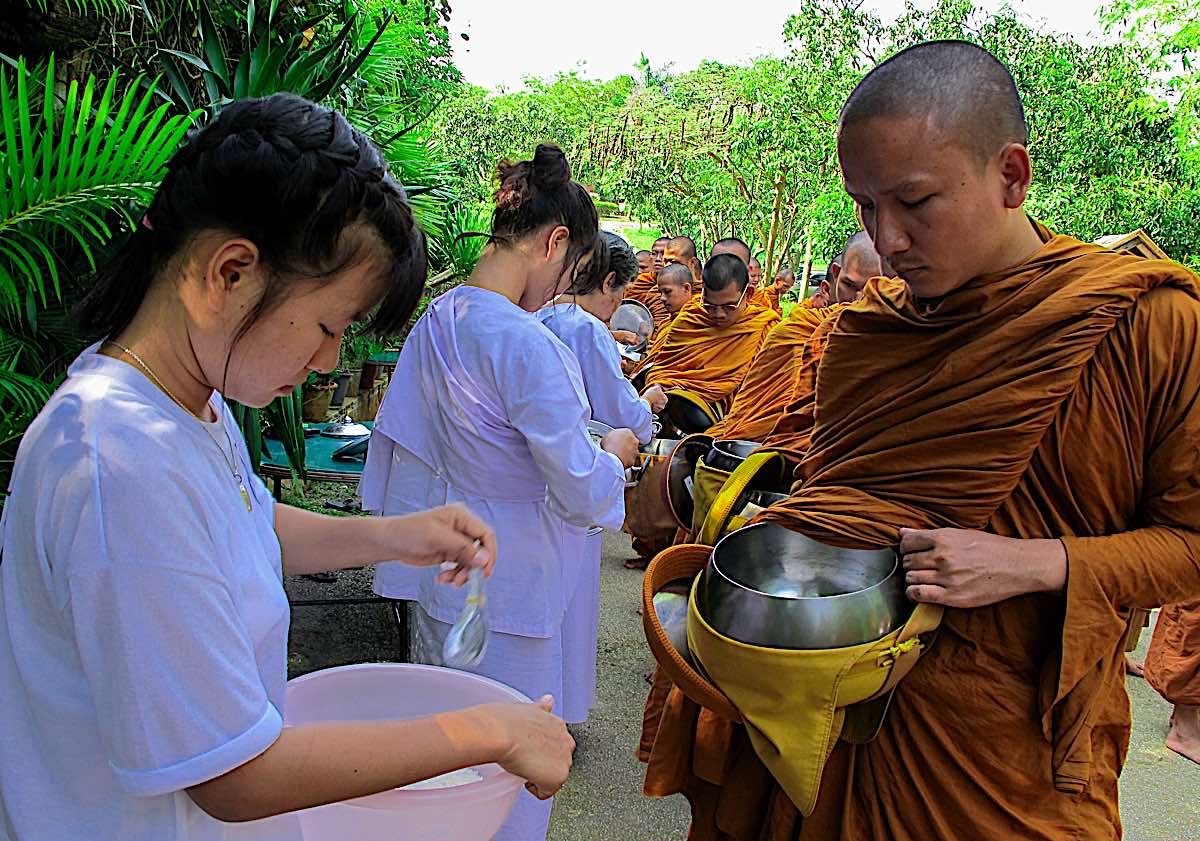
3. Practicing Bodhichitta
Bodhichitta is the mind of awakening, and on Chokhor Duchen we try to cultivate this precious attitude. There are many ways to do this, but one practice that is particularly effective is called “The Seven-Point Mind Training” (lojong in Tibetan). This practice helps us to develop compassion and love for all beings, even those who seem difficult to love.
Reciting the King of Prayers is a strong Bodhichitta practice (here in Sanskrit with English translations):
4. Giving Charity
On Chokhor Duchen, we remember the importance of giving and helping those in need. This can be done in many ways, such as giving money, food or clothes to those who are less fortunate. It’s also important to remember that charity doesn’t have to be material — it can be something as simple as offering a kind word or lending a helping hand.
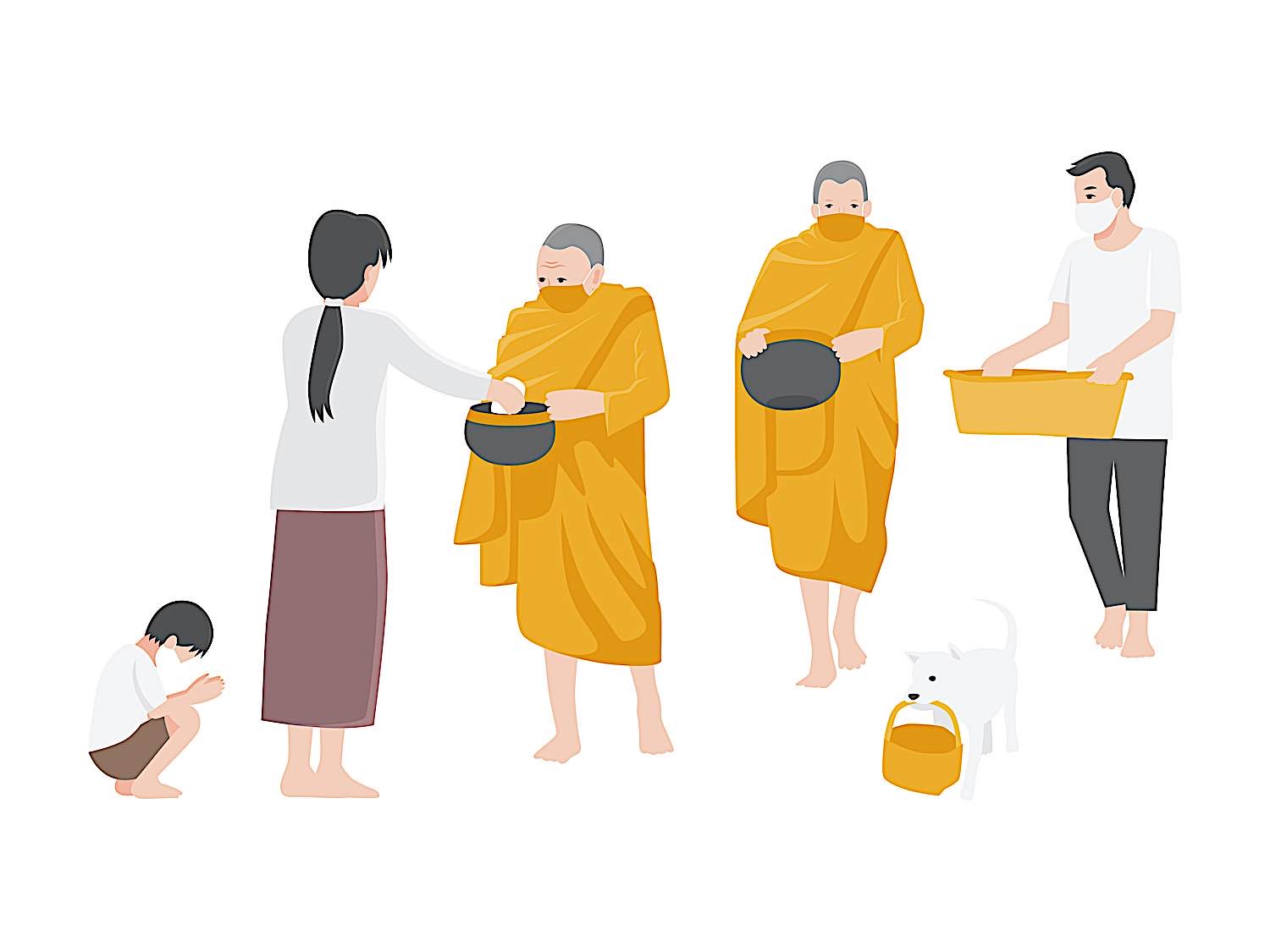
5. Taking the Eight Mahayana Precepts for the Day
The Eight Mahayana Precepts are a set of guidelines for ethical living, and on Chokhor Duchen we take them especially seriously. This is because the precepts help us to purify our negativities and cultivate positive actions. Taking the precepts is an excellent way to make our Chokhor Duchen celebration more meaningful. Lay practitioners normally follow five lay precepts, but on Holy Days, it is recommended to follow all eight. [For a feature on the Eight Precepts, see “Precepts for the Holy Day” section below.]
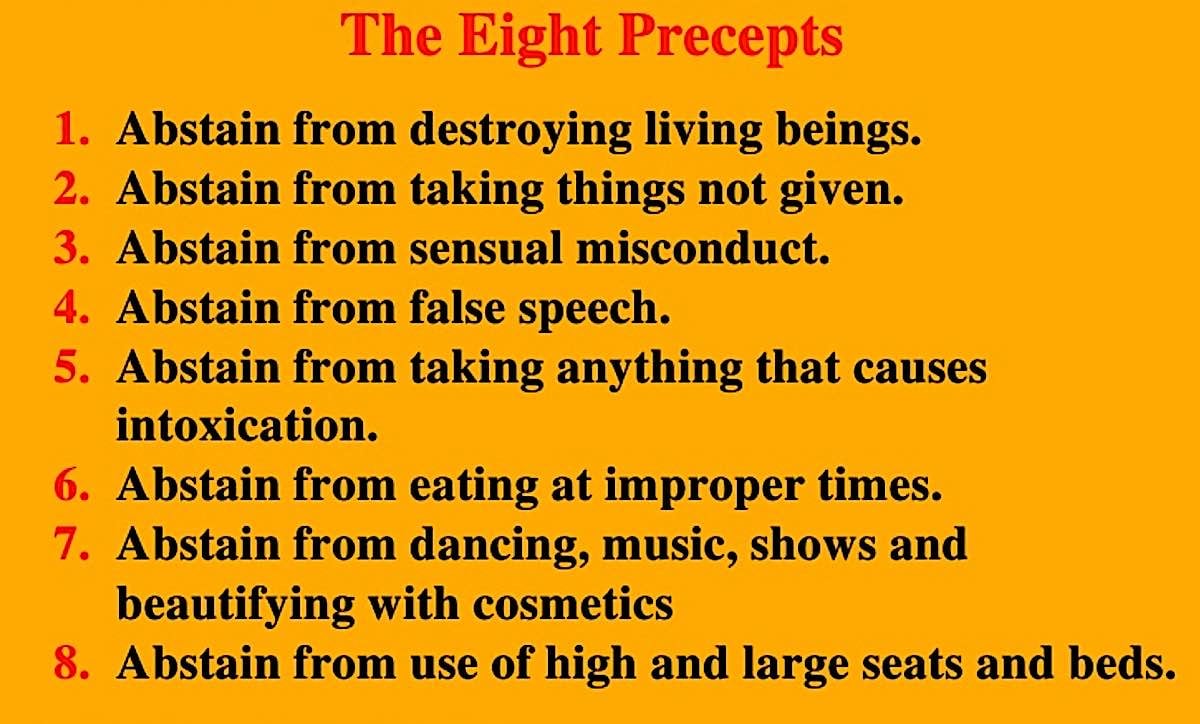
6. Doing a Water Bowl Offering Ceremony
A water bowl offering ceremony is a practice in which we offer water to the Buddhas and bodhisattvas. This practice helps us to purify our negativities and accumulate merit. It’s also a great way to show our respect for the Three Jewels. [For a feature on water bowl offering and its benefits, see>>]
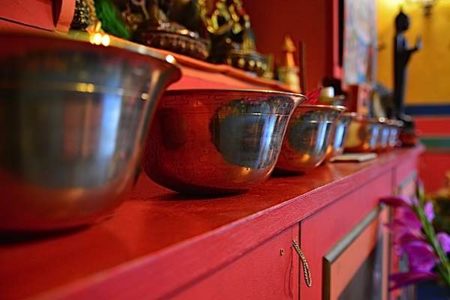
7. Developing the Paramita of Wisdom by Studying Dharma Texts
The paramita of wisdom refers to the perfection of wisdom, and on Chokhor Duchen we especially focus on developing this quality. One way to do this is by studying Dharma texts. This helps us to understand the teachings of the Buddha and put them into practice in our own lives. One text to study, of course, on his day, would be the Prajnaparamita Sutras themselves, and especially the short Heart Sutra.
- For a feature on the Heart Sutra, see>>
- Heart Sutra text>>
- For a feature on the benefits or reading sutras out loud, see>>
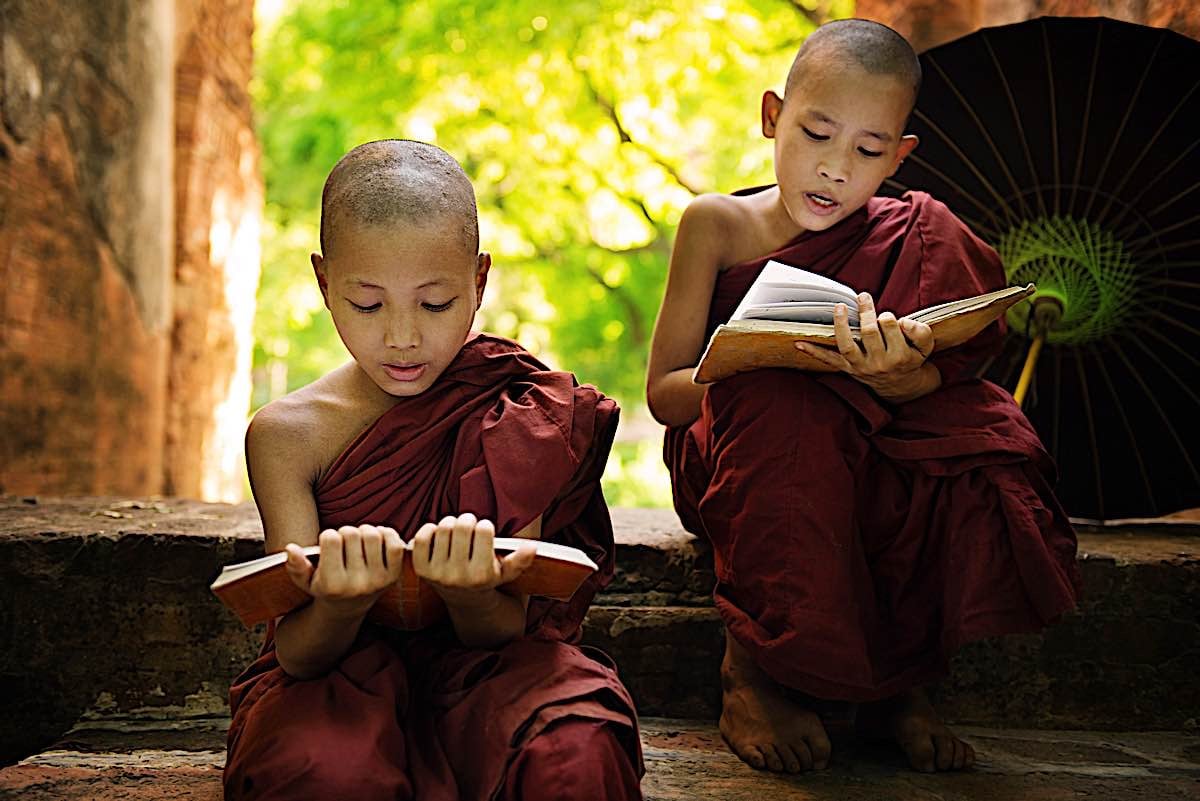
8. Doing Prostrations to the Buddha or Taking Refuge in the Three Jewels
On Chokhor Duchen, we remember the importance of taking refuge in the Three Jewels — the Buddha, Dharma and Sangha. This can be done in many ways, but one particularly effective way is by doing prostrations to the Buddha. Prostrating helps us to develop a sense of respect and humility, which are essential qualities for taking refuge in the Three Jewels.
Taking Refuge and Bodhichitta (daily practice, but extremely meritorious on Buddha Day) chanted in Tibetan by Yoko Dharma:
No matter what you do on Chokhor Duchen, the most important thing is to remember the spirit of the day — to benefit others and yourself. By practicing bodhichitta and living in accordance with the precepts, we can create tremendous merit and make our Chokhor Duchen celebration truly meaningful.
No time for other practices? Chant Shakyamuni’s mantra
If you have no time for other practices, throughout the day, simply chant Shakyamuni Buddha’s mantra, while keeping your mind focused on the Great Conqueror. Of course, ideally, on such a Holy Day, more extensive practices are recommended.
Shakyamuni Mantra Video
Here is a beautiful Sanskrit version, 1 hour of full chanting of Shakyamuni Buddha’s Mantra. The mantra is
Om Muni Muni Mahamuni Shakyamuni Svaha
This translates as “Homage to the Sage, the Sage, the Great Sage Shakyamuni, Well Said.” and is considered a highly meritiorious practice. If we combine with prostrations, or accumulations of mantras for dedication of the merit for the benefit of all sentient beings, it is considered the most precious of practices:
Here’s is a beautiful video with chanting of the mantra in Tibetan Style (Soha instead of Svaha) by the amazing Yoko Dharma:
The Precepts for the Holy Day
Any day, a devout practicing Buddhist tries to observe the five precepts — ideally recite them aloud, then follow them for the day at least:
- “I undertake the training-precept to abstain from onslaught on breathing beings.” (Pali: Pāṇātipātā veramaṇī sikkhāpadaṃ samādiyāmi.)
- “I undertake the training-precept to abstain from taking what is not given.” (Pali: Adinnādānā veramaṇī sikkhāpadaṃ samādiyāmi.)
- “I undertake the training-precept to abstain from misconduct concerning sense-pleasures.” (Pali: Kāmesumicchācāra veramaṇī sikkhāpadaṃ samādiyāmi.)
- “I undertake the training-precept to abstain from false speech.” (Pali: Musāvādā veramaṇī sikkhāpadaṃ samādiyāmi.)
- “I undertake the training-precept to abstain from alcoholic drink or drugs that are an opportunity for heedlessness.” (Pali: Surāmerayamajjapamādaṭṭhānā veramaṇī sikkhāpadaṃ samādiyāmi.)
However, the devout Buddhist who is a lay practitioner — on days such as Wesak — usually tries to observe the Eight Precepts of ordained Buddhists for the day, as training in morality and humility.

The remaining three precepts
The remaining three precepts, for special days (or ordained practitioners all of the time), would be:
6. I undertake to abstain from eating at the wrong time — the correct time is after sunrise but before noon.
7. I undertake to abstain from singing, dancing, playing music, attending entertainment performances, wearing perfume, and using cosmetics and garlands or decorations.
8. I undertake to abstain from luxurious places for sitting or sleeping, and overindulging in sleep.
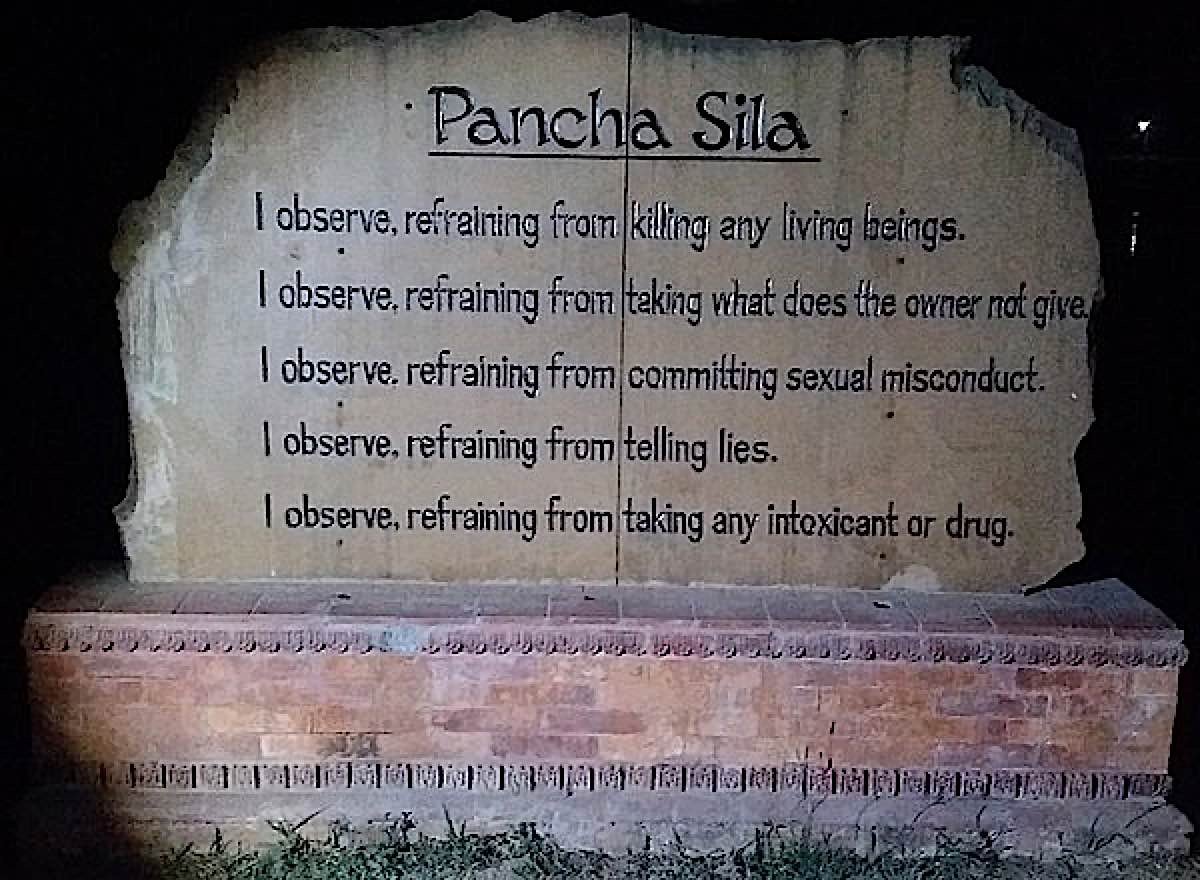
Buddha’s Previous Lives: Video
For all family members, gathering together to read the beautiful Jataka Tales — the previous lives of the Buddha — is a time-honored tradition. Or, watch one in our series of Jataka tales narrated and visualized in this video:
Shakyamuni Buddha Practices
Specific practices and pujas or prayers honoring the glorious Buddha Shakyamuni Buddha can be found freely available online, for example, this excellent resource at Lotsawa House (available in multiple languages)>>
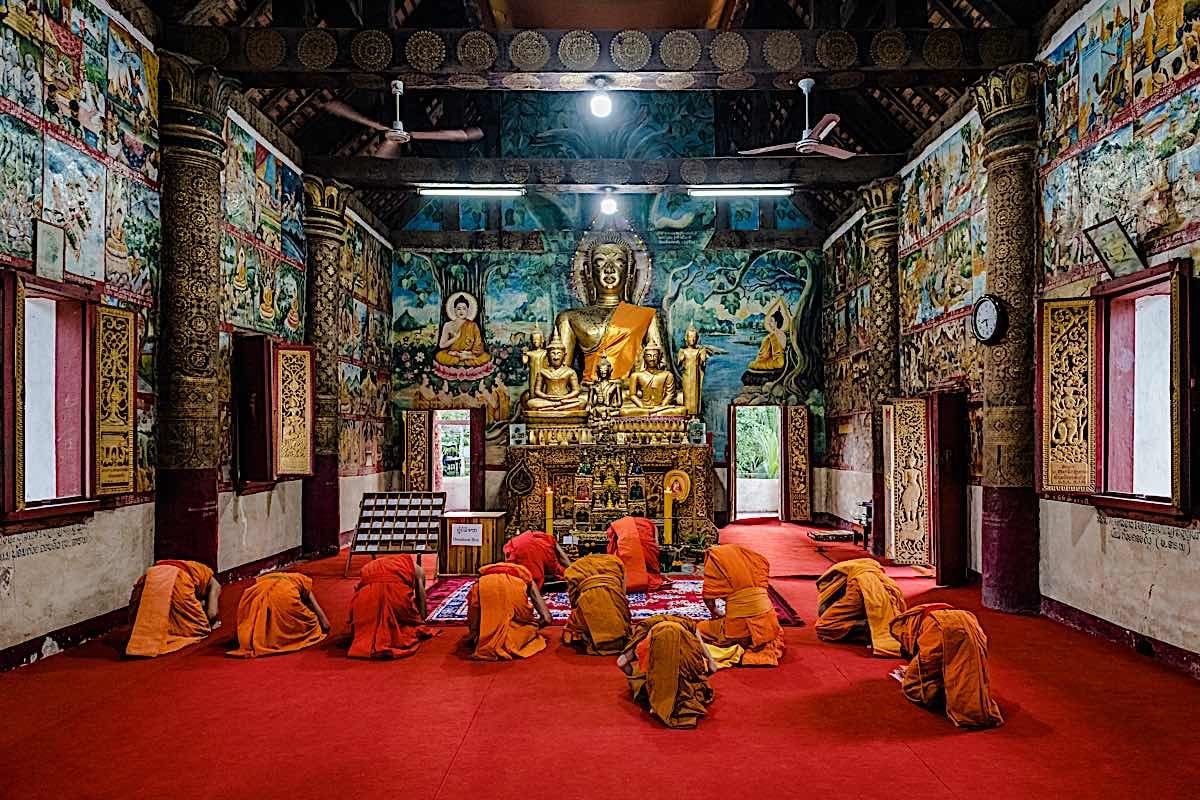
Homage to all the Enlightened Ones: Prayer and Mantras
Another important practice for Holy Days is to give Homage to all the Enlightened Ones with their mantras. For this, the Homage to the Buddhas and Bodhisattvas together with their Mantras by Kyabje Trulshik Rinpoche is a valuable, short practice. Rinpoche himself recommended this practice for all Holy Days and especially “and on the four great anniversaries of our Teacher Śākyamuni.”
༄༅། །རྒྱལ་བ་སྲས་དང་བཅས་པའི་མཚན་ཕྱག་འགའ་ཞིག་མཆོག་དམན་ཀུན་གྱི་ཞལ་འདོན་དུ་བསྒྲིགས་པ་བཞུགས་སོ། །
Verses of Homage to the Buddhas and Bodhisattvas Together with their Mantras Arranged for Recitation by Practitioners of All Levels
by Kyabjé Trulshik Rinpoche

༈ བདག་ཅག་གི་སྟོན་པ་ཐུགས་རྗེ་ཅན་ཤཱཀྱ་ཐུབ་པའི་ནི།
Our Compassionate Teacher, Śākyamuni
སྙིང་རྗེ་ཆེན་པོས་རྩོད་ལྡན་སྙིགས་མའི་ཞིང༌། །
nyingjé chenpö tsöden nyikmé zhing
With your great compassion, you embraced this turbulent and degenerate world,
བཟུང་ནས་སྨོན་ལམ་ཆེན་པོ་ལྔ་བརྒྱ་བཏབ། །
zung né mönlam chenpo ngabgya tab
And made five hundred mighty aspirations.
པད་དཀར་ལྟར་བསྔགས་མཚན་ཐོས་ཕྱིར་མི་ལྡོག །
pekar tar ngak tsen tö chir mindok
You are as exalted as the white lotus; whoever hears your name shall never return to saṃsāra—
སྟོན་པ་ཐུགས་རྗེ་ཅན་ལ་ཕྱག་འཚལ་ལོ། །
tönpa tukjé chen la chaktsal lo
Most compassionate teacher, to you I pay homage!
བླ་མ་སྟོན་པ་བཅོམ་ལྡན་འདས་དེ་བཞིན་གཤེགས་པ་དགྲ་བཅོམ་པ་ཡང་དག་པར་རྫོགས་པའི་སངས་རྒྱས་དཔལ་རྒྱལ་བ་ཤཱཀྱ་ཐུབ་པ་ལ་ཕྱག་འཚལ་ལོ། །
lama tönpa chomdendé dezhin shekpa drachompa yangdakpar dzokpé sangye pal gyalwa shakya tubpa la chaktsal lo
Supreme teacher, bhagavān, tathāgata, arhat, complete and perfect buddha, glorious conqueror, Śākyamuni, to you I bow! To you I pay homage!
མཆོད་དོ་སྐྱབས་སུ་མཆིའོ། །ཞེས་དང༌།
chö do kyab su chi o
In you I take refuge!
བྱིན་གྱིས་བརླབ་ཏུ་གསོལ། །
jingyi lab tu sol
Grant your blessings, I pray!
ཏདྱ་ཐཱ། ཨོཾ་མུ་ནེ་མུ་ནེ་མ་ཧཱ་མུ་ན་ཡེ་སྭཱ་ཧཱ།
teyata om muné muné maha munayé soha
tadyathā oṃ mune mune mahāmunaye svāhā
༈ དཔལ་རྡོ་རྗེ་སེམས་དཔའ་ནི།
Glorious Vajrasattva
མི་རྟོག་རྡོ་རྗེ་ཐབས་ཀྱི་ཡེ་ཤེས་ནི། །
mintok dorjé tap kyi yeshe ni
You are the primordial awareness of skilful means—the indestructible state beyond all concepts,
དམིགས་མེད་ཤེས་རབ་ཡུམ་གྱི་ངང་དུ་རྟོགས། །
mikmé sherab yum gyi ngang du tok
Realized in the nature of the Great Mother, transcendental wisdom free from any reference,
ཐུགས་རྗེའི་བྱེ་བྲག་སྣ་ཚོགས་ཅིར་ཡང་སྟོན། །
tukjéi chedrak natsok chir yang tön
Displaying your compassion, in all its variety, in every kind of way—
རྡོ་རྗེ་སེམས་དཔའ་ཆེ་ལ་ཕྱག་འཚལ་ལོ། །ཅེས་དང་།
dorjé sempa ché la chak tsal lo
O Great Vajrasattva, to you I pay homage!
ཨོཾ་བཛྲ་སཏྭ་ཨཱཿ ཞེས་སོ། །
om benza sato ah
oṃ vajrasattva āḥ
༈ བཅོམ་ལྡན་འདས་ཚེ་དང་ཡེ་ཤེས་དཔག་ཏུ་མེད་པའི་ནི།
Amitāyus, Buddha of Limitless Life and Wisdom
འཇིག་རྟེན་འདྲེན་པའི་གཙོ་བོ་ཚེ་དཔག་མེད། །
jikten drenpé tsowo tsepakmé
Buddha of Infinite Life, foremost guide for beings in this world,
དུས་མིན་འཆི་བ་མ་ལུས་འཇོམས་པའི་དཔལ། །
dü min chiwa malü jompé pal
Your glory overcomes all untimely death,
མགོན་མེད་སྡུག་བསྔལ་གྱུར་པ་རྣམས་ཀྱི་སྐྱབས། །
gönmé dukngal gyurpa nam kyi kyab
You are a refuge for those of us who suffer without protection—
སངས་རྒྱས་ཚེ་དཔག་མེད་ལ་ཕྱག་འཚལ་ལོ། །ཞེས་དང༌།
sangye tsepakmé la chak tsal lo
To you, Buddha Amitāyus, I pay homage!
ཨོཾ་ཨ་མ་ར་ཎི་ཛཱི་ཝནྟི་ཡེ་སྭཱ་ཧཱ། ཞེས་སོ། །
om amarani dziwenti ye soha
oṃ amaraṇi jīvantaye svāhā
༈ འོད་དཔག་མེད་ནི།
Amitābha, Buddha of Limitless Light
བདེ་ཆེན་ཞིང་དུ་ཆོས་ཀྱི་འཁོར་ལོ་བསྐོར། །
dechen zhing du chö kyi khorlo kor
In the realm of Sukhāvatī, you turn the wheel of Dharma,
སེམས་ཅན་རྣམས་ལ་རྟག་ཏུ་ཐུགས་རྗེས་གཟིགས། །
semchen nam la taktu tukjé zik
Gazing on living beings with all your compassion,
དམ་བཅའ་ཇི་བཞིན་འགྲོ་བའི་དོན་མཛད་པ། །
damcha jizhin drowé tön dzepa
And acting for their benefit, just as you vowed—
སྣང་མཐའ་མཉམ་བཞག་མཛད་ལ་ཕྱག་འཚལ་ལོ། །ཅེས་དང་།
nang ta nyamzhak dze la chak tsal lo
To you, Amitābha resting in meditation, I pay homage!
ཨོཾ་ཨ་མི་དྷེ་ཝ་ཧྲཱིཿ ཞེས་སོ། །
om amidhewa hrih
oṃ amitābha1 hrīḥ
༈ རིན་ཆེན་གཙུག་ཏོར་ཅན་གྱི་ནི།
Buddha Ratnaśikhin
བཅོམ་ལྡན་འདས་དེ་བཞིན་གཤེགས་པ་དགྲ་བཅོམ་པ་ཡང་དག་པར་རྫོགས་པའི་སངས་རྒྱས་རིན་ཆེན་གཙུག་ཏོར་ཅན་ལ་ཕྱག་འཚལ་ལོ། །
chomdendé deshin shekpa drachompa yangdakpar dzokpé sangye rinchen tsuktor chen la chak tsal lo
Bhagavān, tathāgata, arhat, complete and perfect buddha, Ratnaśikhin, to you I bow! To you I pay homage!
མཆོད་དོ་སྐྱབས་སུ་མཆིའོ། །ཞེས་དང༌།
chö do kyab su chi o
In you I take refuge!
བྱིན་གྱིས་བརླབ་ཏུ་གསོལ། །
jingyi lab tu sol
Grant your blessings, I pray!
ཏདྱ་ཐཱ། རཏྣེ་རཏྣེ་རཏྣ་ཤི་ཁེ་ནེ་སྭཱ་ཧཱ། ཞེས་སོ། །
teyata ratné ratné ratna shikhene soha
tadyathā ratna ratna ratnaśikhene svāhā
༈ བཅོམ་ལྡན་འདས་སྨན་གྱི་བླའི་ནི།
Blessed Bhaiṣajya Guru, Buddha of Medicine
ཐུགས་རྗེ་ཀུན་ལ་སྙོམས་པའི་བཅོམ་ལྡན་འདས། །
tukjé kün la nyompé chomdendé
Blessed one, whose compassion for all is equal,
མཚན་ཙམ་ཐོས་པས་ངན་འགྲོའི་སྡུག་བསྔལ་སེལ། །
tsen tsam töpé ngendro dukngal sel
Simply hearing your name dispels the suffering of lower realms,
དུག་གསུམ་ནད་སེལ་སངས་རྒྱས་སྨན་གྱི་བླ། །
duk sum nesel sangye men gyi la
Buddha of Medicine, you who heal the sickness of the three poisons—
བཻ་ཌཱུརྻ་ཡི་འོད་ལ་ཕྱག་འཚལ་ལོ། །ཞེས་དང༌།
bendurya yi ö la chak tsal lo
Light of Lapis Lazuli, to you I pay homage!
བཅོམ་ལྡན་འདས་དེ་བཞིན་གཤེགས་པ་དགྲ་བཅོམ་པ་ཡང་དག་པར་རྫོགས་པའི་སངས་རྒྱས་སྨན་གྱི་བླ་བཻ་ཌཱུརྻ་འོད་ཀྱི་རྒྱལ་པོ་ལ་ཕྱག་འཚལ་ལོ། །
chomdendé dezhin shekpa drachompa yangdakpar dzokpé sangye men gyi la bendurya ö kyi gyalpo la chaktsal lo
Bhagavān, tathāgata, arhat, complete and perfect buddha, Buddha of Medicine, Radiant Light of Lapis Lazuli King, to you I bow! To you I pay homage!
མཆོད་དོ་སྐྱབས་སུ་མཆིའོ། །ཞེས་དང༌།
chö do kyap su chi o
In you I take refuge!
ཏ་དྱ་ཐཱ༔ ཨོཾ་བྷཻ་ཥ་ཛྱེ་བྷཻ་ཥ་ཛྱེ་མ་ཧཱ་བྷཻ་ཥ་ཛྱེ་བྷཻ་ཥ་ཛྱེ༔ རཱ་ཛ་ས་མུདྒ་ཏེ་སྭཱ་ཧཱ༔
teyata | om bhekandze bhekandze maha bekhandze bhekandze | radza samudgaté soha
tadyathā oṃ bhaiṣajye bhaiṣajye mahābhaiṣajye bhaiṣajyarājasamudgate svāhā
ཞེས་གཟུངས་སྔགས་ཅི་འགྲུབ་བཟླ༔
༈ རྒྱལ་ཚབ་བྱམས་པ་མགོན་པོའི་ནི།
Buddha’s Regent, the Protector Maitreya
བྱམས་ཆེན་མེ་ཡིས་ཞེ་སྡང་བུད་ཤིང་བསྲེགས། །
cham chen mé yi zhe dang bü zhing sek
The fire of your great love burns up the dry wood of hate,
ཡེ་ཤེས་འོད་ཀྱིས་མ་རིག་མུན་པ་སེལ། །
yeshe ö kyi marik münpa sel
The light of your wisdom dispels the darkness of ignorance,
ཆོས་ཀྱི་རྒྱལ་ཚབ་འགྲོ་བའི་མགོན་གྱུར་པའི། །
chö kyi gyaltsap drowé gön gyurpé
Dharma regent, protector of all living beings,
དགའ་ལྡན་བཞུགས་པ་དེ་ལ་ཕྱག་འཚལ་ལོ། །ཞེས་དང༌།
ganden zhukpa de la chak tsal lo
Who dwells in the Tuṣita heaven—to you I pay homage!
ཨོཾ་མ་ཏི་མ་ཏི་སྨྲྀ་ཏི་སྭཱ་ཧཱ། ཞེས་སོ། །
om mati mati smriti soha
oṃ mati mati smṛti svāhā
༈ འཕགས་པ་སྤྱན་རས་གཟིགས་ཀྱི་ནི།
Noble Avalokiteśvara
ཕྱག་སྟོང་འཁོར་ལོས་སྒྱུར་བའི་རྒྱལ་པོ་སྟོང༌། །
chak tong korlö gyurpé gyalpo tong
Your thousand arms are the thousand universal monarchs,
སྤྱན་སྟོང་བསྐལ་པ་བཟང་པོའི་སངས་རྒྱས་སྟོང༌། །
chen tong kalpa zangpöi sangye tong
Your thousand eyes the thousand buddhas of this fortunate age,
གང་ལ་གང་འདུལ་དེ་ལ་དེར་སྟོན་པའི། །
gang la gang dul dela der tönpé
You who teach each and every one of us according to our needs,
བཙུན་པ་སྤྱན་རས་གཟིགས་ལ་ཕྱག་འཚལ་ལོ། །ཞེས་དང༌།
tsünpa chenrezik la chak tsal lo
Lord Avalokiteśvara, to you I pay homage!
ཨོཾ་མ་ཎི་པདྨེ་ཧཱུྂ་ཧྲཱིཿ
om mani pemé hung hrih
oṃ maṇi padme hūṃ hrīḥ
ཞེས་སྦྱར་ནའང་རུང་བར་གསུངས་སོ། །
It is said to be acceptable to add the final syllable hrīḥ.
༈ རྗེ་བཙུན་འཕགས་པ་འཇམ་དཔལ་དབྱངས་ཀྱི་ནི།
Noble Lord Mañjuśrī
ཤེས་བྱའི་མཁའ་དབྱིངས་ཟབ་ཅིང་ཡངས་པ་ལ། །
shejé kha ying zap ching yangpa la
Across the skies of all that can be known, profound and infinite,
བློ་གྲོས་དཀྱིལ་འཁོར་རྒྱས་པའི་འོད་ཟེར་གྱིས། །
lodrö kyilkhor gyepé özer gyi
Shine vast rays of light from the sun of your intelligence,
སྐྱེ་དགུའི་མ་རིག་མུན་པའི་ཚོགས་བསལ་བ། །
kye güi marik münpé tsok salwa
Dispelling the darkness of ignorance in all beings’ minds—
རྗེ་བཙུན་འཇམ་དཔལ་དབྱངས་ལ་ཕྱག་འཚལ་ལོ། །ཞེས་དང༌།
jetsün jampalyang la chak tsal lo
Lord Mañjughoṣa, to you I pay homage!
ཨོཾ་ཨ་ར་པ་ཙ་ན་དྷཱིཿ ཞེས་སོ། །
om arapatsana dhih
oṃ arapacana dhīḥ
༈ རྡོ་རྗེ་རྣམ་འཇོམས་ནི།
Vajravidāraṇa
༈ གང་ཐུགས་གཉིས་སུ་མེད་པའི་ཡེ་ཤེས་ཀྱིས། །
gang tuk nyi su mepé yeshe kyi
With the non-dual wisdom of your enlightened mind,
རྡོ་རྗེ་རིན་ཆེན་ཀུན་ནས་འབར་བའི་མཐུས། །
dorjé rinchen kun nas barwé tü
And through the power of your blazing vajra and jewel,
བདུད་བཞིའི་སྟོབས་རྣམས་རྣམ་པར་འཇོམས་མཛད་པ། །
dü zhi top nam nampar jom dzepa
You vanquish completely the forces of the four māras,
རྡོ་རྗེ་རྣམ་པར་འཇོམས་ལ་ཕྱག་འཚལ་བསྟོད། །ཞེས་དང༌།
dorjé nampar jom la chak tsal tö
Vajravidāraṇa, to you we offer homage and praise!
དེ་བཞིན་གཤེགས་པ་ཐམས་ཅད་ཀྱི། །
deshin shekpa tamché kyi
All the buddhas’ power and strength
མཐུ་སྟོབས་གཅིག་ཏུ་འདུས་པའི་བདག །
tu top chiktu düpé dak
Is condensed within you alone,
རྡོ་རྗེ་ཁྲོ་བོའི་སྐུར་སྟོན་པ། །
dorjé trowöi kur tönpa
Who manifest as the enlightened form of vajra wrath—
རྣམ་པར་འཇོམས་ལ་ཕྱག་འཚལ་ལོ། ཞེས་དང་། །
nampar jom la chak tsal lo
Vajravidāraṇa, to you I pay homage!
ན་མཤྕཎྜ་བཛྲ་ཀྲོ་དྷ་ཡ། ཧུ་ལུ་ཧུ་ལུ། ཏིཥྛ་ཏིཥྛ། བྷནྡྷ་བྷནྡྷ། ཧ་ན་ཧ་ན། ཨ་མྲྀ་ཏེ་ཧཱུྃ་ཕཊ། ཞེས་སོ། །
namash chanda benza krodhaya | hulu hulu | tishtha tishtha | bhendha bhendha | hana hana | amrité hung pé
namaścaṇḍa vajrakrodhāya | hulu hulu | tiṣṭha tiṣṭha | bhandha bhandha | hana hana | amṛte hūṃ phaṭ
༈ འཕགས་མ་རྣམ་པར་རྒྱལ་མའི་ནི།
Noble Vijayā, Goddess of Victory
དཔལ་ལྡན་ལྷ་མོ་སྟོན་ཀའི་ཟླ་བའི་མདོག །
palden lhamo tönké dawé dok
Glorious goddess, your colour that of the autumn moon,
ཞལ་གསུམ་ཕྱག་བརྒྱད་རབ་མཛེས་ཞི་བའི་སྐུ། །
zhal sum chak gye rab dzé zhiwé ku
With three faces and eight arms, your form ravishing and serene,
ཡེ་ཤེས་དཔག་ཡས་ཚེ་ཡི་མཆོག་སྩོལ་མ། །
yeshe pakyé tsé yi chok tsolma
You grant the supreme gifts of longevity and boundless wisdom—
རྣམ་པར་རྒྱལ་མའི་ཞབས་ལ་ཕྱག་འཚལ་ལོ། །ཞེས་དང༌།
nampar gyalmé zhap la chak tsal lo
Noble Vijayā, to you I pay homage!
ཨོཾ་ཨ་མྲྀ་ཏ་ཨཱ་ཡུརྡ་དེ་སྭཱ་ཧཱ། ཞེས་སོ། །
om amrita ayurdadé soha
oṃ amṛtāyurdade svāhā
༈ རྗེ་བཙུན་འཕགས་མ་སྒྲོལ་མའི་ནི།
Noble Saviouress Tārā
བདག་གིས་ཚེ་རབས་སྔོན་ནས་བསྒྲུབས་པའི་ལྷ། །
dak gi tserap ngön né druppé lha
Deity on whom I meditated in lives gone by,
དུས་གསུམ་སངས་རྒྱས་ཀུན་གྱི་ཕྲིན་ལས་མ། །
dü sum sangye kün gyi trinléma
You are the enlightened activity of all buddhas, past, present, and future,
རབ་དཀར་ཞལ་གཅིག་ཕྱག་གཉིས་སྤྱན་བདུན་མ། །
rap kar zhal chik chak nyi chen dün ma
Brilliant white, with your one face, two hands, and seven eyes,
ཡུམ་གྱུར་ཨུཏྤལ་བསྣམས་ལ་ཕྱག་འཚལ་ལོ། །ཞེས་དང༌།
yum gyur utpala nam la chak tsal lo
Mother of the buddhas, holder of the utpala flower, to you I pay homage!
ཨོཾ་ཏཱ་རེ་ཏུཏྟཱ་རེ་ཏུ་རེ་སྭཱ་ཧཱ། ཞེས་སོ། །
om taré tuttaré turé soha
oṃ tāre tuttāre ture svāhā
༈ རྒྱལ་ཀུན་འདུས་ཞལ་གུ་རུའི་གསོལ་འདེབས་ནི།
Prayer to the Guru, the Embodiment of All the Buddhas
སྤྲུལ་པའི་གུ་རུ་མཚན་བརྒྱད་དང༌། །
trulpé guru tsen gyé dang
To the eight manifestations of Guru Rinpoche,
གྲུབ་པའི་རིག་འཛིན་ཆེན་པོ་བརྒྱད། །
druppé rigzin chenpo gyé
The eight great accomplished vidyādharas,
བྱང་སེམས་ཉེ་བའི་སྲས་བརྒྱད་དང༌། །
changsem nyewé sé gye dang
The eight great bodhisattvas, the ‘close sons’,
སྒྲུབ་ཆེན་བཀའ་བརྒྱད་ལྷ་ཚོགས་ལ། །
drupchen kagyé lha tsok la
The eight maṇḍalas of Kagyé with all their deities:
གསོལ་བ་འདེབས་སོ་བྱིན་གྱིས་རློབས། །
solwa depso chin gyi lop
To you I pray—inspire me with your blessings!
ཕྱི་ནང་གསང་བའི་བར་ཆད་སོལ། །
chi nang sangwé barché sol
Dispel all obstacles outer, inner and secret!
བསམ་པ་ཡིད་བཞིན་འགྲུབ་པ་དང༌། །
sampa yizhin druppa dang
Fulfill all my aspirations!
མཆོག་དང་ཐུན་མོང་དངོས་གྲུབ་སྩོལ། །ཞེས་དང༌།
chok dang tünmong ngödrup tsol
Grant us attainments, ordinary and supreme!
ཨོཾ་ཨཱཿཧཱུྂ་བཛྲ་གུ་རུ་པདྨ་སིདྡྷི་ཧཱུྂ། ཞེས་སོ། །
om ah hung benza guru pema siddhi hung
oṃ āḥ hūṃ vajra guru padma siddhi hūṃ
༈ མཐར་དྲག་པོ་རྟ་ཕྱག་ཁྱུང་དྲིལ་གྱི་ནི།
Finally, the Wrathful Union of Hayagrīva, Vajrapāṇi and Garuḍa
ཕྱོགས་བཅུའི་རྒྱལ་བ་ཀུན་གྱི་སྐུ་གསུང་ཐུགས། །
chok chüi gyalwa kün gyi ku sung tuk
You are the wisdom body, speech and mind of all the buddhas of the ten directions,
བྱ་ཁྱུང་རྒྱལ་པོ་རྟ་མགྲིན་གསང་བའི་བདག །
cha khyung gyalpo tamdrin sangwé dak
The kingly Garuḍa, Hayagrīva and the Lord of Secrets
རང་བཞིན་གཅིག་ཏུ་ཉེར་བསྟན་ཁྲོ་བོའི་གཙོ། །
rangzhin chiktu nyer ten trowöi tso
Manifesting as one deity, foremost among the wrathful.
དྲན་པས་བགེགས་དཔུང་འཇོམས་ལ་ཕྱག་འཚལ་བསྟོད། །ཞེས་དང༌།
drenpé gek pung jom la chak tsal tö
The very thought of you crushes obstructing forces—and to you I offer homage and praise!
ཨོཾ་བཛྲ་པཱ་ཎི་ཧ་ཡ་གྲཱྀ་བ་ག་རུ་ཌ་ཧཱུྂ་ཕཊ། ཅེས་སོ། །
om vajrapani hayagriva garuda hung pé
oṃ vajrapāṇi hayagrīva garuḍa hūṃ phaṭ
Dedication
དགེ་བ་འདི་ཡིས་མྱུར་དུ་བདག །
gewa di yi nyurdu dak
Through this merit, may I swiftly accomplish the realization
སྲས་བཅས་རྒྱལ་བ་འགྲུབ་གྱུར་ནས། །
seché gyalwa drup gyur né
Of the buddhas and their bodhisattva heirs
འགྲོ་བ་གཅིག་ཀྱང་མ་ལུས་པ། །
drowa chik kyang malüpa
And may I bring each and every single living being
དེ་ཡི་ས་ལ་འགོད་པར་ཤོག །ཞེས་དང༌།
de yi sa la göpar shok
To that perfect state as well.
༈ བྱང་ཆུབ་སེམས་མཆོག་རིན་པོ་ཆེ། །
changchup sem chok rinpoche
Bodhicitta, precious and sublime:
མ་སྐྱེས་པ་རྣམས་སྐྱེས་པ་དང༌། །
makyepa nam kyepa dang
May it arise in those in whom it has not arisen;
སྐྱེས་པ་ཉམས་པ་མེད་པ་ཡང༌། །
kyepa nyampa mepa yang
May it never decline where it has arisen;
གོང་ནས་གོང་དུ་འཕེལ་བར་ཤོག །
gong né gong du pelwar shok
May it go on increasing, further and further!
༈ སྟོང་ཉིད་ལྟ་བ་རིན་པོ་ཆེ། །
tongnyi tawa rinpoche
The precious view of śūnyatā,
མ་རྟོགས་པ་རྣམས་རྟོགས་པ་དང༌། །
matokpa nam tokpa dang
May it be realized by those who have not realized it;
རྟོགས་པ་ཉམས་པ་མེད་པ་ཡང༌། །
tokpa nyampa mepa yang
May it never decline where it has been realized;
གོང་ནས་གོང་དུ་འཕེལ་བར་ཤོག །ཅེས་སོ། །
gong né gong du pelwar shok
May it go on increasing, further and further!
དེ་ལྟར་ཁོ་བོར་ཆོས་འབྲེལ་གསན་མཁན་རྣམས་ནས་ཉིན་རེ་བཞིན་ཡོངས་རྫོགས་གྲུབ་ན་རབ། དེ་མིན་གང་མོས་དང༌། ལྷག་པར་ཟླ་བ་འབྱུང་ངོ་ཅོག་གི་ཉ་སྟོང་བརྒྱད་གསུམ་སོགས་དང༌། སྟོན་པའི་དུས་ཆེན་ཁག་བཞི་སོགས་སུ་གང་འགྲུབ་པ་ཞལ་འདོན་དུ་མཛད་ཚེ་ཕན་ཡོན་ཚད་མེད་པ་འབྱུང་བ་ལགས་སོ་ཞེས་ཐལ་མོ་སྦྱར་པ་པོ་སྟེ། ཤཱཀྱའི་དགེ་སྦྱོང་ཀུན་རྨོངས་ཞྭ་དེའུ་པ་ངག་དབང་ཆོས་ཀྱི་བློ་གྲོས་སོ། །
For all of you who have received teachings from me and have a Dharma connection with me, it would be best to recite all these prayers and mantras every day. Otherwise, recite whichever you wish, especially on the 8th, 15th and 30th days of the lunar month, and on the four great anniversaries of our Teacher Śākyamuni. Whenever you do so, the benefit will be immeasurable. I, the Zhadeupa Ngawang Chökyi Lodrö, an ignorant monk of Śākyamuni, entreat you with folded hands.
ཤུབྷཾ།། །།སརྦ་མངྒ་ལཾ།།
Śubham. Sarva Maṅgalaṃ.
| Rigpa Translations 2011, revised 2016.
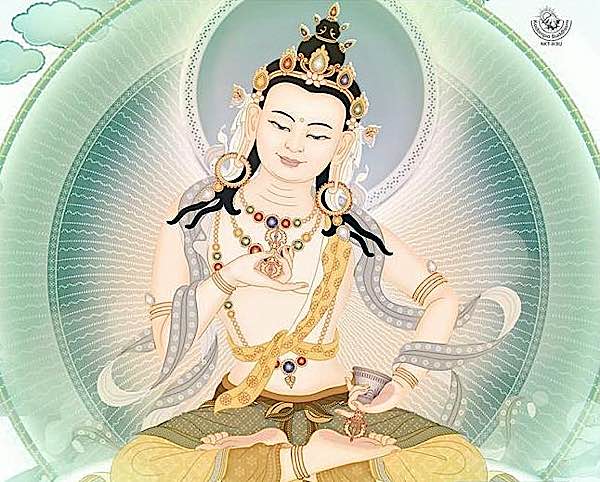
Vajrasattva Purification
Another practice recommended by various teachers in Tibetan Buddhism is Vajrasattva practice, sadhanas, pujas or mantras. Since merit is multiplied, it is important to take advantage of this opportunity to purify our negative karmas.
- See our previous feature on Vajrasattva here>>
- Video guided meditation on Vajrasattva here>>
- Podcast version of guided meditation on Vajrasattva here>>
Practices recommended by Lama Zopa Rinpoche for these special days:
- Taking the eight Mahayana precepts: students can receive the lineage of these precepts from a specially produced video of Lama Zopa Rinpoche granting them, which was edited from Lama Zopa Rinpoche’s Teachings on Thought Transformation during the Time of COVID-19 and Practice Advice at Kopan Monastery recorded in May 2020.
- Reciting the Sutra Remembering the Three Jewels
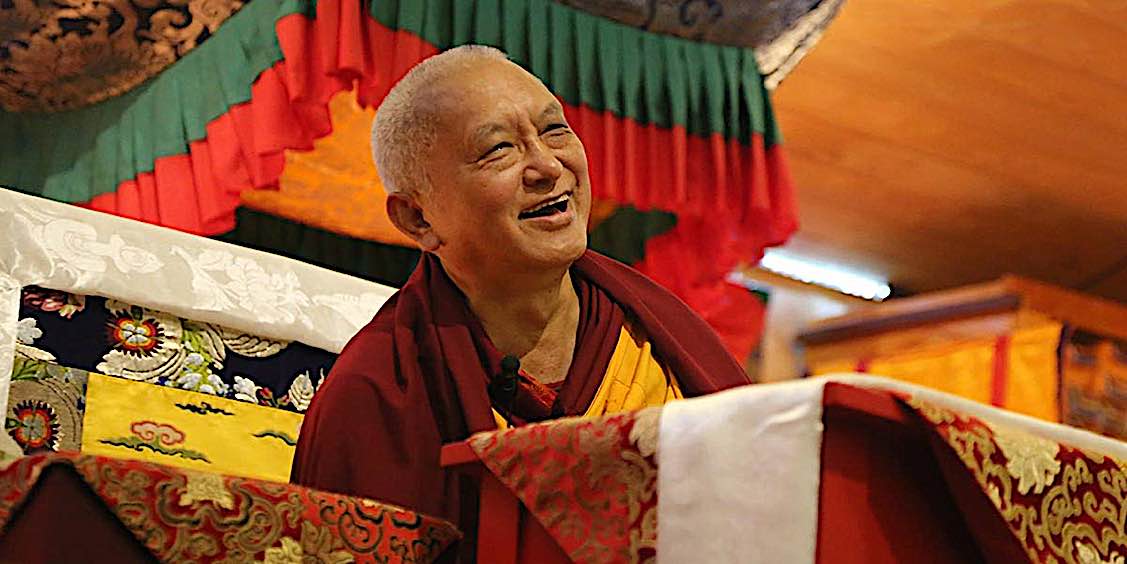
Other recommended practices include:
- Performing the Guru Shakyamuni Buddha puja. A beautiful and deeply inspirational puja. The puja text is formatted with hyperlinks for smooth navigation, so that individuals can easily do the core practice and any additional ones as their time allows. (This puja was performed with Khandro Kunga Bhuma on Vesak Day 2022 at Losang Dragpa Centre in Malaysia, with its resident teacher, Geshe Jampa Tsondu, as chant master. You can watch this online, starting at 6:10 in the video.)
- Reciting sutras, such as Vajra Cutter Sutra, Sutra of Golden Light, and Sanghata Sutra
- Undertaking Nyung nes
- Performing self-initiation, for those who fulfilled the necessary prerequisites
- Performing Lama Chopa, and at either the beginning of the practice or during the lamrim section, you can meditate on emptiness
- Reciting other prayers, such as Chanting the Names of Manjushri, and King of Prayers
- Reciting the names of the Thirty-Five Buddhas, with prostrations
- Reciting Vajrasattva mantras
- Reciting OṂ MAṆI PADME HŪṂ with bodhichitta
- Meditating on emptiness and dependent arising
- Meditating on bodhichitta
- Practicing tonglen
- Rejoicing
- Liberating animals [2]
Tonglen teaching visualization video
Tonglen is a visualized Bodhichitta practice that is considered very meritorious and beneficial for all sentient beings.
Enjoy this guided meditation on Tonglen:
From FPMT’s newsletter on Chokhor Duchen:
“Chokhor Duchen, one of the four annual holy days of Guru Shakyamuni Buddha, takes place this year on August 1. On these holy days, the power of any meritorious action is multiplied by 100 million, as taught in the vinaya text Treasure of Quotations and Logic.”
Known in English as “Turning the Wheel of Dharma,” Chokhor Duchen commemorates the anniversary of Guru Shakyamuni Buddha’s first teaching. It is said that for seven weeks after his enlightenment, the Buddha did not teach. Afterward, Indra and Brahma offered a dharmachakra and a conch shell, and requested Guru Shakyamuni Buddha to teach. Accepting, Guru Shakyamuni Buddha turned the wheel of Dharma for the first time at Sarnath in his teaching on the four noble truths.”
Buddha’s First Teaching at Deer Park
These two extremes, monks, are not to be practiced
by one who has gone forth from the world.
What are the two?
That joined with the passions and luxury—
low, vulgar, common, ignoble, and useless,
and that joined with self-torture—
painful, ignoble, and useless.
Avoiding these two extremes the one who has thus come
has gained the enlightenment of the middle path,
which produces insight and knowledge,
and leads to peace, wisdom, enlightenment, and nirvana.
And what, monks, is the middle path, by which
the one who has thus come has gained enlightenment,
which produces knowledge and insight,
and leads to peace, wisdom, enlightenment, and nirvana?
This is the noble eightfold way, namely,
right understanding, right intention,
right speech, right action, right livelihood,
right attention, right concentration,
and right meditation.
This, monks, is the middle path, by which
the one who has thus come has gained enlightenment,
which produces insight and knowledge,
and leads to peace, wisdom, enlightenment, and nirvana.
Now this, monks, is the noble truth of pain:
birth is painful; old age is painful;
sickness is painful; death is painful;
sorrow, lamentation, dejection, and despair are painful.
Contact with unpleasant things is painful;
not getting what one wishes is painful.
In short the five groups of grasping are painful.
Now this, monks, is the noble truth of the cause of pain:
the craving, which leads to rebirth,
combined with pleasure and lust,
finding pleasure here and there,
namely the craving for passion,
the craving for existence,
and the craving for non-existence.
Now this, monks, is the noble truth
of the cessation of pain:
the cessation without a remainder of craving,
the abandonment, forsaking, release, and non-attachment.
Now this, monks, is the noble truth
of the way that leads to the cessation of pain:
this is the noble eightfold way, namely,
correct understanding, correct intention,
correct speech, correct action, correct livelihood,
correct attention, correct concentration,
and correct meditation.
“This is the noble truth of pain”:
Thus, monks, among doctrines unheard before,
in me insight, wisdom, knowledge, and light arose.
“This noble truth of pain must be comprehended.”
Thus, monks, among doctrines unheard before,
in me insight, wisdom, knowledge, and light arose.
“It has been comprehended.”
Thus, monks, among doctrines unheard before,
in me insight, wisdom, knowledge, and light arose.
“This is the noble truth of the cause of pain”:
Thus, monks, among doctrines unheard before,
in me insight, wisdom, knowledge, and light arose.
“The cause of pain must be abandoned.”
Thus, monks, among doctrines unheard before,
in me insight, wisdom, knowledge, and light arose.
“It has been abandoned.”
Thus, monks, among doctrines unheard before,
in me insight, wisdom, knowledge, and light arose.
“This is the noble truth of the cessation of pain”:
Thus, monks, among doctrines unheard before,
in me insight, wisdom, knowledge, and light arose.
“The cessation of pain must be realized.”
Thus, monks, among doctrines unheard before,
in me insight, wisdom, knowledge, and light arose.
“It has been realized.”
Thus, monks, among doctrines unheard before,
in me insight, wisdom, knowledge, and light arose.
“This is the noble truth
of the way that leads to the cessation of pain”:
Thus, monks, among doctrines unheard before,
in me insight, wisdom, knowledge, and light arose.
“The way must be practiced.”
Thus, monks, among doctrines unheard before,
in me insight, wisdom, knowledge, and light arose.
“It has been practiced.”
Thus, monks, among doctrines unheard before,
in me insight, wisdom, knowledge, and light arose.
As long as in these four noble truths
my due knowledge and insight
with the three sections and twelve divisions
was not well purified, even so long, monks,
in the world with its gods, Mara, Brahma,
its beings with ascetics, priests, gods, and men,
I had not attained the highest complete enlightenment.
This I recognized.
And when, monks, in these four noble truths
my due knowledge and insight
with its three sections and twelve divisions
was well purified, then monks,
in the world with its gods, Mara, Brahma,
its beings with ascetics, priests, gods, and men,
I had attained the highest complete enlightenment.
This I recognized.
Knowledge arose in me;
insight arose that the release of my mind is unshakable:
this is my last existence;
now there is no rebirth.
Timeline of Buddha’s Life
Although earlier experts placed Buddha’s life at 490 B.C. to 410 B.C., the latest archeological evidence places Buddha’s Birth at 563 B.C. and his Paranirvana at 483 B.C. Dating relates to birth relics recently found, and his Paranirvana dates can be easily reinforced by his funeral relics scattered throughout India and Asia.

563 B.C. Conception to the Sakyas
Sakyamuni (Shakyamuni) Gautama Buddha’s conception — in much of Asia, conception is the celebratory date, rather than the actual date of birth. [2] Famously, Queen Maha Maya, Buddha’s mother, had a conception dream of a white elephant with six tusks descending from heaven to enter her womb. His title Sakyamuni (pronounced Shakyamuni) literally means ‘sage’ of the Sakyans — where Sakya was his father’s kingdom or oligarchic republic (located in modern-day Nepal). Muni literally means “sage.” Śākyamuni (शाक्यमुनि) is title of Buddha fist cited in Mahāprajñāpāramitāśāstra (chapter VI).
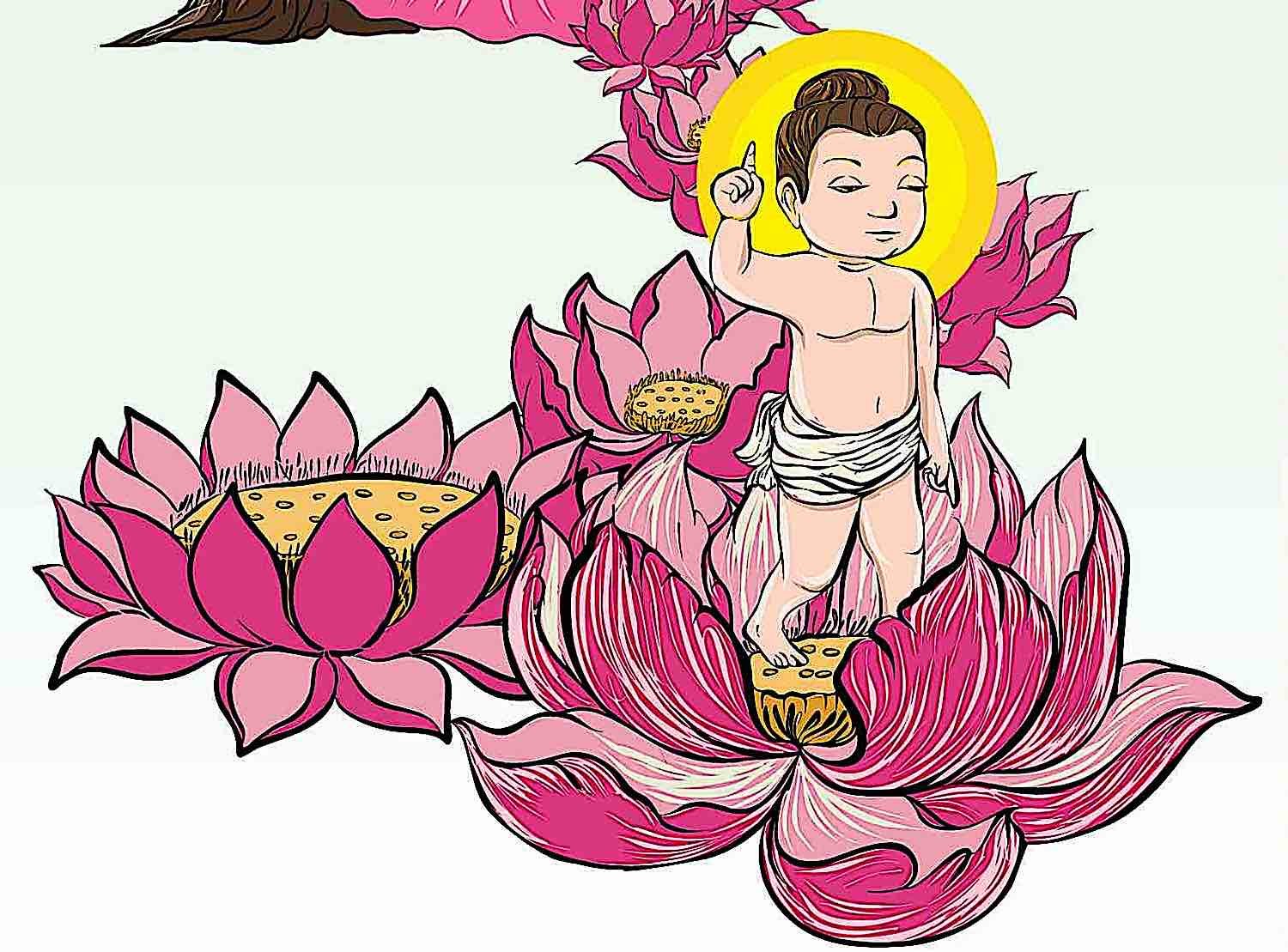
563 B.C. Siddartha’s Birth in Lumbini Nepal
Buddha was actually born Prince Siddartha, in Lumbini Nepal. According to tradition:
“Buddha emerged from his mother’s side, as she stood leaning against a tree, in a painless and pure birth.” [2]
He was named Siddartha (or Sarvathasiddha) — literally meaning “a man who achieves his goals” — by his father the king, who was determined he would be a great worldly king and conqueror, not a Buddha as predicted by the sages. His mother passed away, and he was brought up by his aunt Mahaprajapati.
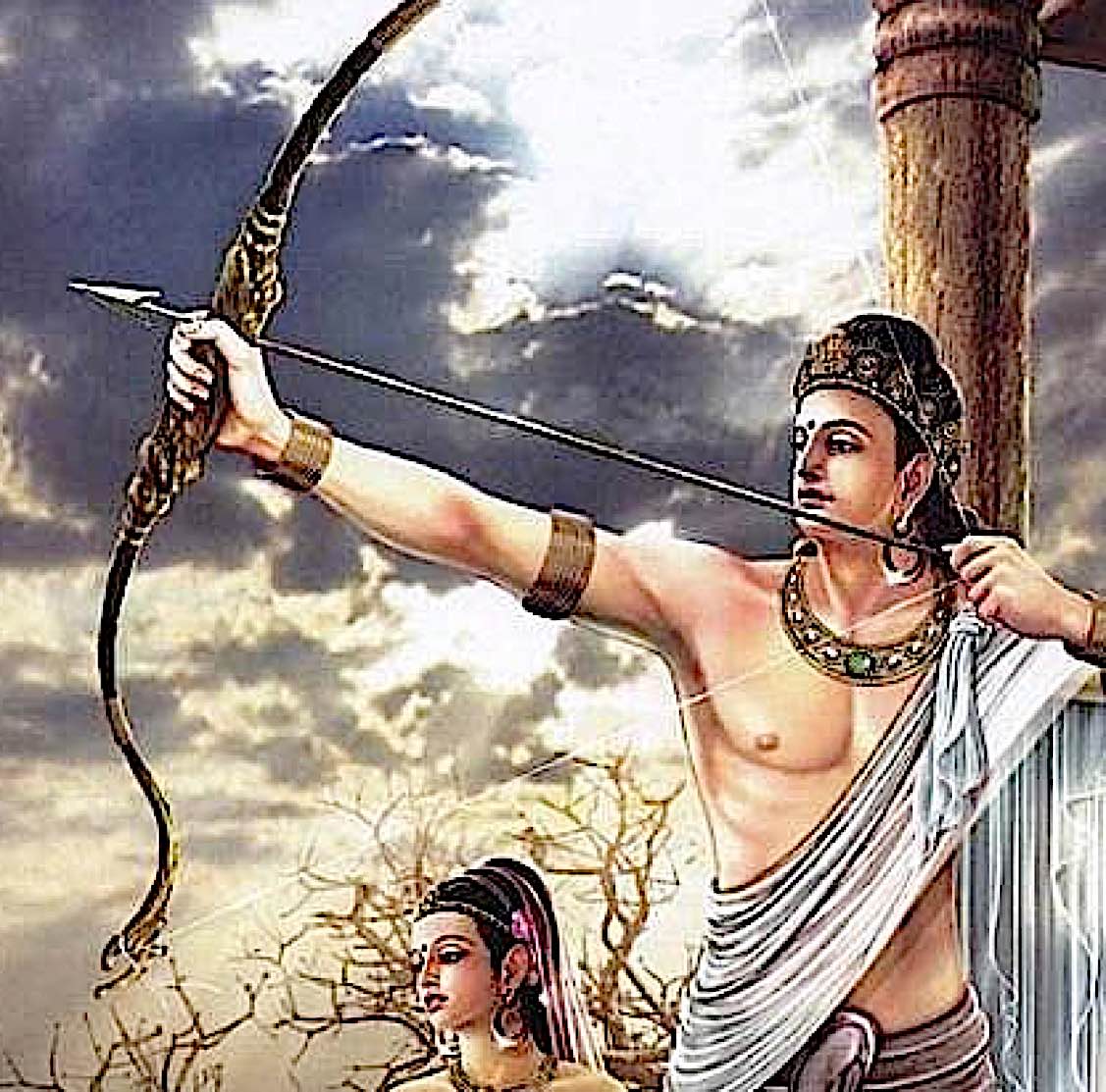
548 B.C. Siddartha’s marriage to Yasodhara
His father the king determined he must be sheltered from the suffering of the world to remove any causes that might arise compassion in the young prince. True to his father’s aspirations, he was brought up a privileged prince, sequestered in the palace. He was married to young Yasodhara, who conceived their son Rahula.
Siddartha grew up in Kapilavastu, the capital, and became very accomplished in “kingly arts” including the martial arts.
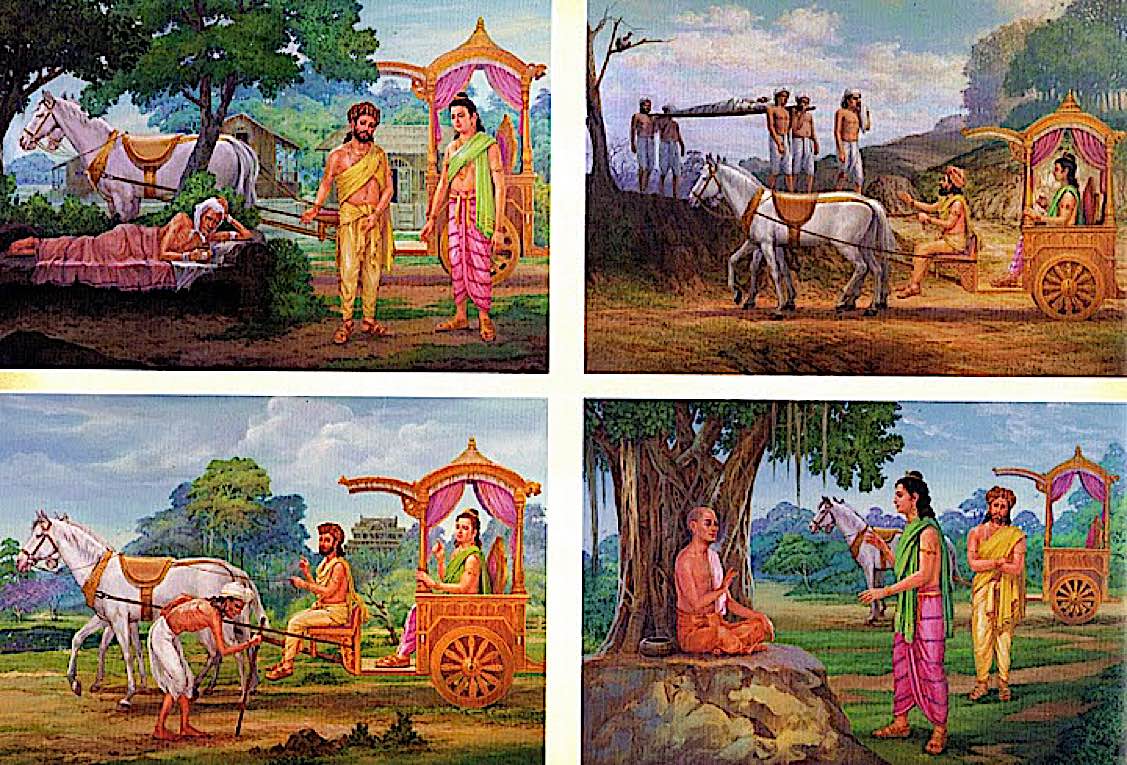
534 B.C. Buddha sees the four sights: suffering
True to predictions of the sages — and despite his father’s fiercely protective tactics — Prince Siddartha escaped the palace and saw the four sights of suffering: poverty, illness, old age, and death. He also saw religious ascetics. His “existential crisis” [2] led to his life’s mission — to release the world from all suffering.
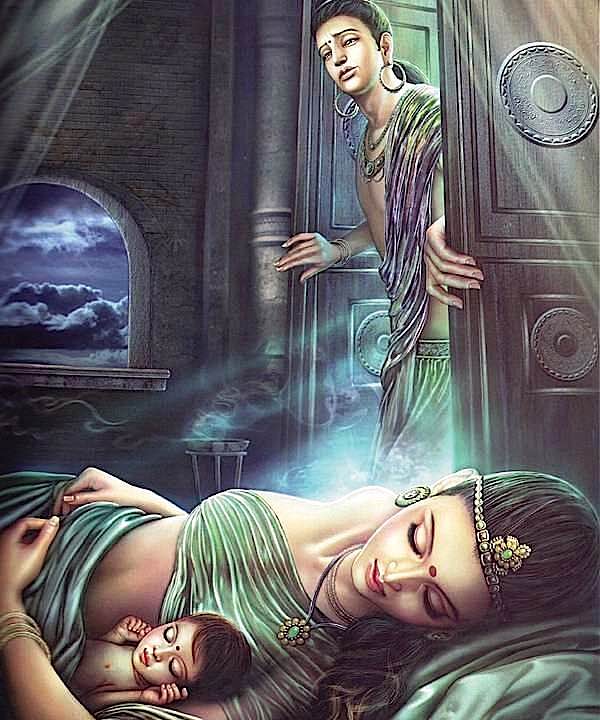
534 B.C. Siddartha leaves home
With compassion awake in the young Prince Siddartha, he became driven to overcome the suffering of Samsara. In a dramatic moment, Siddartha determined to leave home — quietly leaving the palace to avoid his father’s guards. He knew he must abandon his conventional, privileged life, to seek the answers that would save all beings from the eternal cycle of suffering.
Dramatically, he left his beloved wife and child — knowing he must for the ultimate benefit — cut his hair and left behind even his inseparable horse. Cutting his hair was a symbol of leaving behind his ordinary life. He traveled south, seeking out other spiritual seekers, and ended in Magadha (current Bihar) where he begged on the streets.
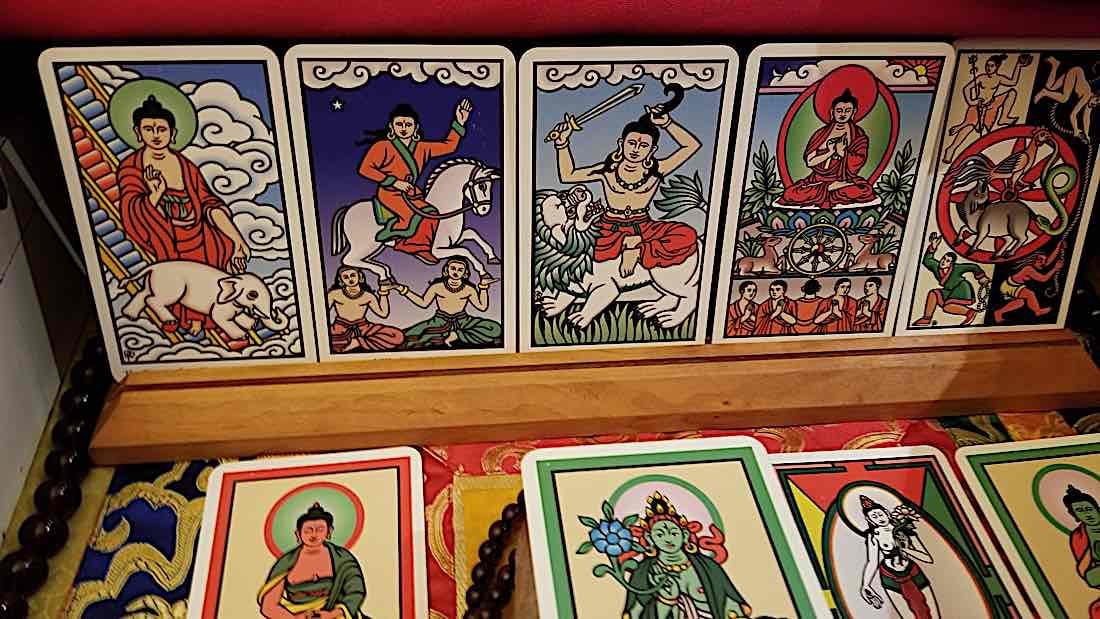
533 B.C. Siddartha Meditates in Magadha
Like most spiritual seekers, Siddartha sought out and trained with many meditation teachers — notably “the masters Ālāra Kālāma and Uddaka Rāmaputta” [2]
He learned and mastered with the best of the great sages of the time, attaining great realizations, but not the ultimate solution. He determined they did not have the final “permanent” solution, and decided he must seek the solution on his own.

532-5238 B.C. Siddartha the Ascetic
Asceticism was an extreme form of practice that included living in the wild without protection, extreme fasting — basically, an attempt to “down the physical influence of one’s being and release the soul, an insubstantial essence in each individual.” [2]
He continued this until he was nothing but dry skin and bones, close to death.
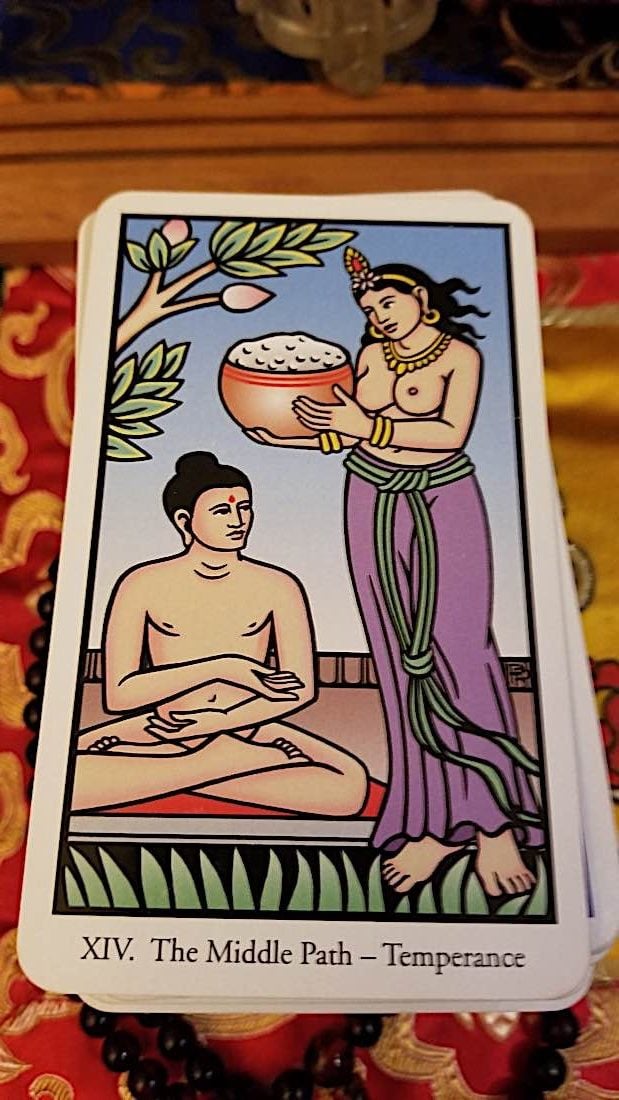
528 B.C. Siddartha risks death at Varanasi
Pushing his practice to the extreme, he tried every extreme meditation and practice — together with five other ascetics — only to nearly die of starvation. Finally, he realized the “middle way” was the correct path to Enlightenment — neither the extreme of deprivation nor its opposite of luxury. Barely able to move, he accepted a tiny bowl of mik, rice from a devotee named Sujata. From that moment, he pioneered the “Middle Path” now known as “Buddhism.”

528 B.C. Awakening at Bodh Gaya
At Buddhism’s most “famous” site, Bodhgaya, Siddartha found the liberating path. Rejected by the five ascetics, he ate modest meals, recovering his strength, then moved to a new meditation site under the most famous tree in history — the Pipal Tree of Bodh Gaya. [A decedent of this tree is still honored today in Bodhgaya.]
He withdrew into his mind, pioneering a new “middle way” of meditating. He endured trials under the tree, tempted by the Mara and his legions and armies. [Mara and his legions, assailing the Buddha under the tree, can be thought of as the struggle Buddha faced internally with his own attachments and past karmic imprints.] Finally, he awakened, and Mara and his legions vanished. Famously, the symbol of this is Buddha touching the earth as his witness. He attained Bodhi — Awakening — and became the Buddha, the Awakened One.
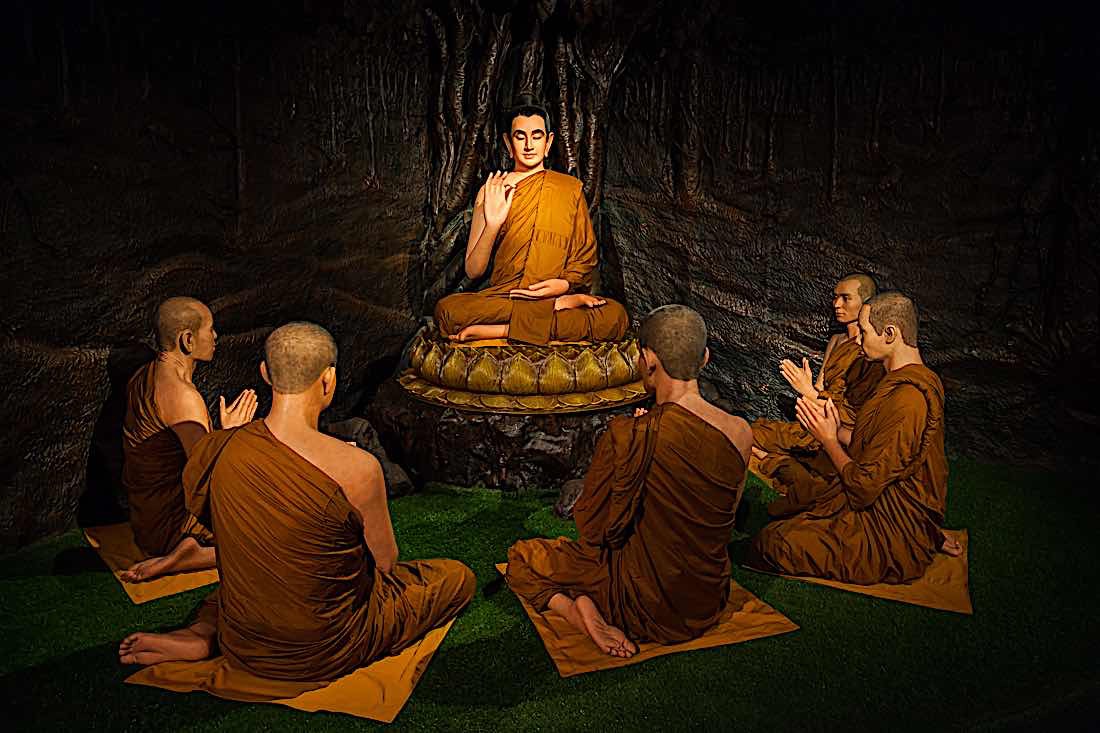
528 B.C. First Teaching at Sarnath
Buddha “turned the first wheel” of teaching, determined to help others with his perfect methods. His first pupils were the five ascetics who had earlier rebuked him. His first teachings were the Four Noble Truths, and the Eightfold Path:
Buddha first taught the Four Noble Truths, the Truth of Suffering, metaphorically, the “disease” we are treating.
“What, monks, is the truth of suffering? Birth is suffering, decay, sickness and death are suffering. To be separated from what you like is suffering. To want something and not get it is suffering. In short, the human personality, liable as it is to clinging and attachment brings suffering.” [3]

Overcoming suffering relied on the Eightfold Path:
“This is the noble eightfold way, namely, right understanding, right intention, right speech, right action, right livelihood, right attention, right concentration, and right meditation.” — Shakyamuni Buddha at Deerpark
• For a feature on the Four Noble Truths and Eightfold Path, see>>
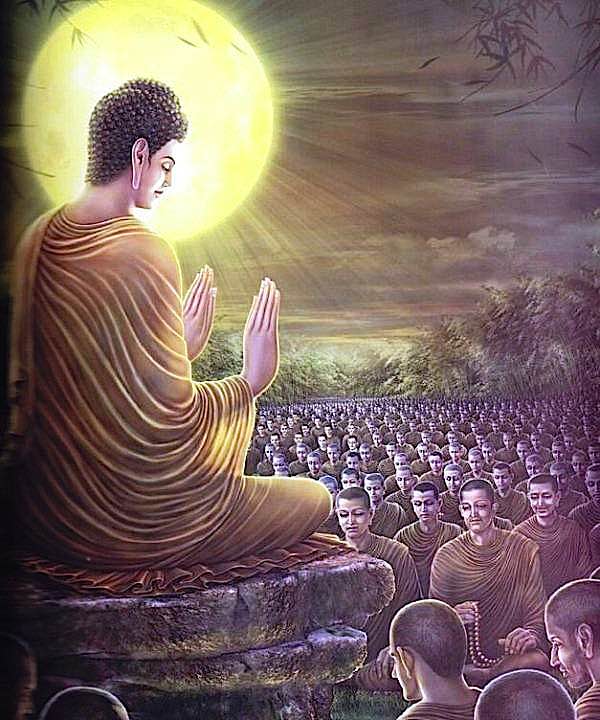
528-483 B.C. Countless teachings, Turning the Wheel
Buddha traveled with a growing entourage of disciples, teaching for the next 45 years. These precious teachings, recorded by his pupils, became a vast body of Pali Sutta, and later Mahayana Sutra — the largest collection of spiritual teachings in history. His teachings would spread throughout India, China, Japan, Korea, and all of Asia — and ultimately around the world.
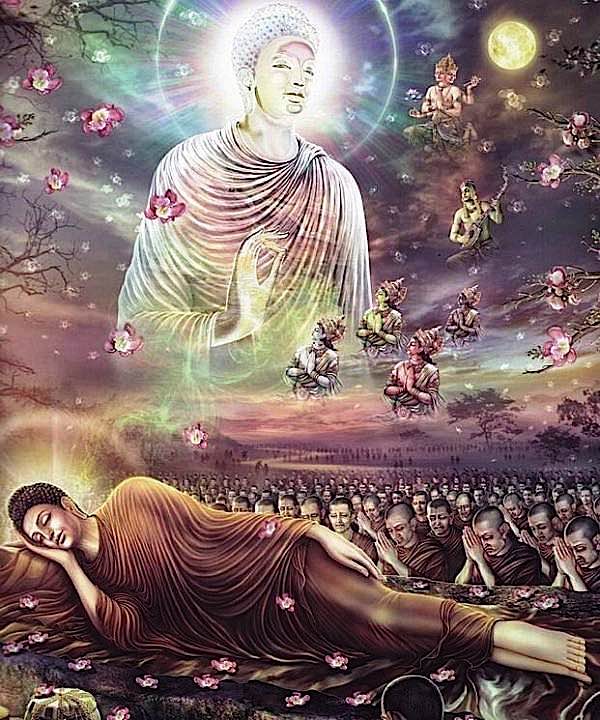
483 B.C. Paranirvana at Kusinagara, Malla
At the age of 80, he decided it was time for him to leave the teachings to his Sangha of disciples. He gave his last teaching. He asked his disciples if they had any last questions for him before he left.
Finally, he said, “Things that arise from causes will also decay. Press on with due care.”[3]
He lay down on his right side, with his hand under his face — in the pose made famous by the Sleeping Buddha statue — and passed into the peace of ultimate Paranirvana. [3]
Chant the Heart Sutra:
To Chant Along: Heart Sutra
THE SUTRA OF THE HEART OF TRANSCENDENT KNOWLEDGE
Thus have I heard. Once the Blessed One was dwelling in Råjagriha at Vulture Peak mountain, together with a great gathering of the sangha of monks and a great gathering of the sangha of bodhisattvas. At that time the Blessed One entered the samådhi that expresses the dharma called “profound illumination,” and at the same time noble Avalokiteshvara, the bodhisattva mahåsattva, while practicing the profound prajñåpåramitå, saw in this way: he saw the five skandhas to be empty of nature.
Then, through the power of the Buddha, venerable Shåriputra said to noble Avalokiteshvara, the bodhisattva mahåsattva, “How should a son or daughter of noble family train, who wishes to practice the profound prajñåpåramitå?”
Addressed in this way, noble Avalokiteshvara, the bodhisattva mahåsattva, said to venerable Shåriputra, “O Shåriputra, a son or daughter of noble family who wishes to practice the profound prajñåpåramitå should see in this way: seeing the five skandhas to be empty of nature. Form is emptiness; emptiness also is form. Emptiness is no other than form; form is no other than emptiness. In the same way, feeling, perception, formation, and consciousness are emptiness. Thus, Shåriputra, all dharmas are emptiness. There are no characteristics.
There is no birth and no cessation. There is no impurity and no purity. There is no decrease and no increase. Therefore, Shåriputra, in emptiness, there is no form, no feeling, no perception, no formation, no consciousness; no eye, no ear, no nose, no tongue, no body, no mind; no appearance, no sound, no smell, no taste, no touch, no dharmas; noeye dhåtu up to no mind dhåtu, no dhåtu of dharmas, no mind consciousness dhåtu; no ignorance, no end of ignorance up to no old age and death, no end of old age and death; no suffering, no origin of suffering, no cessation of suffering, no path, no wisdom, no attainment, and no nonattainment.
Therefore, Shåriputra, since the bodhisattvas have no attainment, they abide by means of prajñåpåramitå. Since there is no obscuration of mind, there is no fear. They transcend falsity and attain complete nirvåna. All the buddhas of the three times, by means of prajñåpåramitå, fully awaken to unsurpassable, true, complete enlightenment.
Therefore, the great mantra of prajñåpåramitå, the mantra of great insight, the unsurpassed mantra, the unequaled mantra, the mantra that calms all suffering, should be known as truth, since there is no deception. The prajñåpåramitå mantra is said in this way:
OM GATE GATE PÅRAGATE PÅRASAMGATE BODHI SVÅHÅ
Thus, Shåriputra, the bodhisattva mahåsattva should train in the profound prajñå-påramitå.”
Then the Blessed One arose from that samådhi and praised noble Avalokiteshvara, the bodhisattva mahåsattva, saying, “Good, good, O son of noble family; thus it is, O son of noble family, thus it is. One should practice the profound prajñåpåramitå just as you have taught and all the tathågatas will rejoice.”
When the Blessed One had said this, venerable Shåriputra and noble Avalokiteshvara, the bodhisattva mahåsattva, that whole assembly and the world with its gods, humans, asuras, and gandharvas rejoiced and praised the words of the Blessed One.
- For Dzongsar Jamyan Kyentse’s Rinpoche’s Facebook page please visit>>
- For more information on Dzongsar Rinpoche, please visit Siddartha’s Intent website>>
Source
[2] Lama Zopa’s Advice for practice with multiplied merit on sacred days>>
[3] Timeline from the BBC documentary studying the evidence of Buddhas Life. BBC: Life of the Buddha, a Spiritual Journey>>
More articles by this author

4 Guardians of the World and Dharma: the Watchers of the World: the Four Heavenly Kings in Buddhism, Their Mantras and Practice
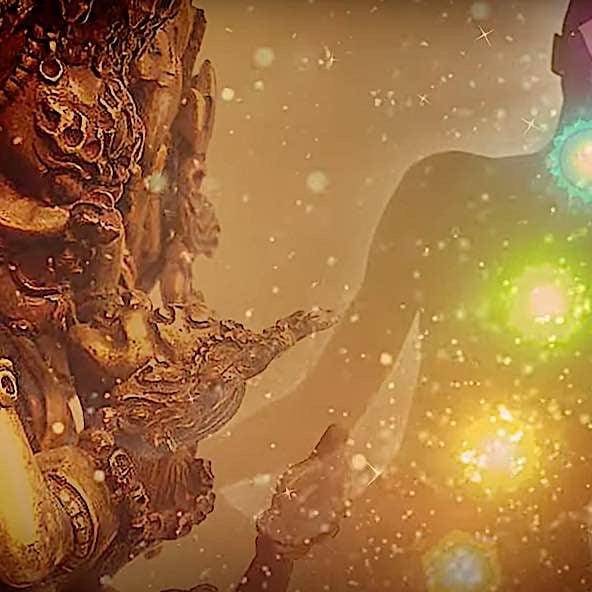
Subtle body as the path to Enlightenment and lighting the inner fire— the five chakras, three channels and two drops of Tantric Buddhism and their practice
Search
Latest Features
Please support the "Spread the Dharma" mission as one of our heroic Dharma Supporting Members, or with a one-time donation.
Please Help Support the “Spread the Dharma” Mission!

Be a part of the noble mission as a supporting member or a patron, or a volunteer contributor of content.
The power of Dharma to help sentient beings, in part, lies in ensuring access to Buddha’s precious Dharma — the mission of Buddha Weekly. We can’t do it without you!
A non-profit association since 2007, Buddha Weekly published many feature articles, videos, and, podcasts. Please consider supporting the mission to preserve and “Spread the Dharma." Your support as either a patron or a supporting member helps defray the high costs of producing quality Dharma content. Thank you! Learn more here, or become one of our super karma heroes on Patreon.
Lee Kane
Author | Buddha Weekly
Lee Kane is the editor of Buddha Weekly, since 2007. His main focuses as a writer are mindfulness techniques, meditation, Dharma and Sutra commentaries, Buddhist practices, international perspectives and traditions, Vajrayana, Mahayana, Zen. He also covers various events.
Lee also contributes as a writer to various other online magazines and blogs.




